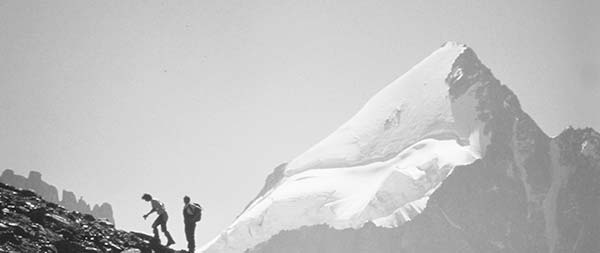
Annecy • Chamonix
Chamonix Activities at a Glance
The Savoie region grows Europe’s highest mountains and is the penthouse of the French Alps (the lower Alpes-Dauphiné lie to the south). More than just a pretty-peaked face, stubborn Savoie maintained its independence from France until 1860, when mountains became targets, rather than obstacles, for travelers. Savoie’s borders once stretched south to the Riviera and far west across the Rhône River Valley. Home to the very first winter Olympics (1924, in Chamonix), today’s Savoie is France’s mountain-sports capital, showcasing 15,780-foot Mont Blanc as its centerpiece. Boasting wooden chalets overflowing with geraniums and cheese fondue in every restaurant, Savoie feels more Swiss than French.
The scenery is drop-dead spectacular. Serenely self-confident Annecy is a postcard-perfect blend of natural and man-made beauty. In Chamonix, it’s just you and Madame Nature—there’s not a museum or important building in sight. Take Europe’s ultimate cable-car ride to the 12,602-foot Aiguille du Midi in Chamonix.
Lakefront Annecy has boats, bikes, and hikes with mountain views for all tastes and abilities. Its arcaded walking streets and good transportation connections (most trains to Chamonix pass through Annecy) make it a convenient stopover, but if you’re pressed for time and antsy for Alps, slide your sled to Chamonix. There you can skip along alpine ridges, glide over mountain meadows, zip down the mountain on a luge (wheeled bobsled), or meander riverside paths on a mountain bike. Plan a minimum of two nights and one day in Chamonix, and try to work in an additional night and a day in Annecy. Weather is everything in this area: Check the forecast. If it looks good, make haste to Chamonix; if it’s gloomy, Annecy offers more distraction.
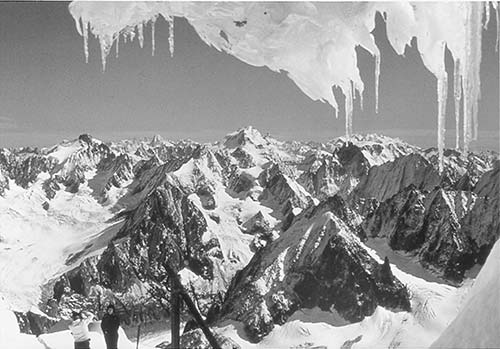
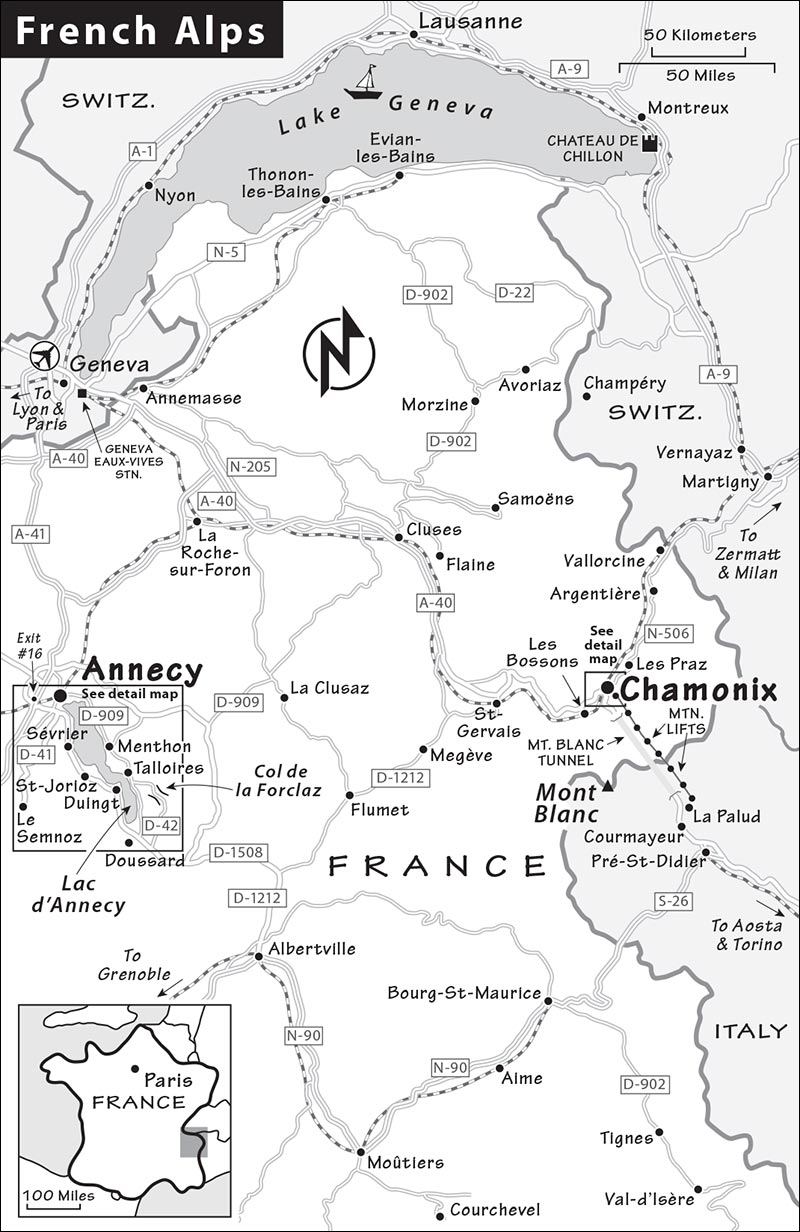
The Alps have twin peaks: the summer and winter seasons, when hotels and trails or slopes are slammed. June and November are dead quiet in Chamonix (many hotels and restaurants close) as locals recover from one high season and prepare for the next.
Annecy and Chamonix are well-connected by train and bus. Buses run from Chamonix to nearby villages, and the Aiguille du Midi lift takes travelers from Chamonix to Italy over Europe’s most scenic border crossing. If you have a car, pricey autoroutes make the going easy, and scenic drives near Annecy allow you to savor remarkable views.
Entering Switzerland by Car: Drivers passing through Switzerland need a “vignette” decal to use Swiss autoroutes (about €36, valid one calendar year, can be used on one car only)—even if only to reach Geneva’s airport from bordering France (though locals suggest this section is not heavily patrolled, and skipping the autoroute via local roads through Geneva is possible but a headache). It’s a €300 fine if you’re caught sans decal. You can buy Swiss vignettes at Annecy’s Mont Blanc Automobile Club (15 Rue de la Préfecture, Mon-Sat 9:00-12:00 & 14:00-18:00, closed Sun) or for a bit more on the autoroute at the border crossing.
Savoie cuisine is mountain-hearty. Its Swiss-similar specialties include fondue savoyarde (melted Beaufort and Comté cheeses and local white wine, sometimes with a dash of Cognac), raclette (chunks of melted cheese served with potatoes, pickles, sausage, and bread), tartiflette (hearty scalloped potatoes with melted cheese), poulet de Bresse (the best chicken in France), Morteau (smoked pork sausage), gratin savoyard (a potato dish with cream, cheese, and garlic), and fresh fish. Look also for pierrades, heated stone blocks delivered to your table along with thinly sliced meats, vegetables, potatoes, and more that you cook on the stone. Local cheeses are Morbier (look for a charcoal streak down the middle), Comté (like Gruyère), Beaufort (aged for two years, hard and strong), Reblochon (mild and creamy), and Tomme de Savoie (mild and semihard). Evian water comes from Savoie, as does Chartreuse liqueur. Apremont and Crépy are two of the area’s surprisingly good white wines. The local beer, Baton de Feu, is more robust than other French beers.
There’s something for everyone in this lakefront city that knows how to entertain: mountain views, romantic canals, a hovering château, and swimming in—or boating on, or biking around—the translucent lake. Sophisticated yet outdoors-oriented and bike-crazy, Annecy (ahn-see) is France’s answer to Switzerland’s Luzern, and, though you may not have glaciers knocking at your door as in nearby Chamonix, the distant peaks frame a darn pretty picture with Annecy’s lakefront setting. Don’t bother with museums in Annecy: You’re here for the vistas, arcaded streets, and outdoor activities. During the winter holidays, Christmas markets and festive decorations animate the city. Annecy is a joy before noon in any season, but high-season weekend afternoons will try your patience. Spend your mornings in the old town and afternoons around the lake.
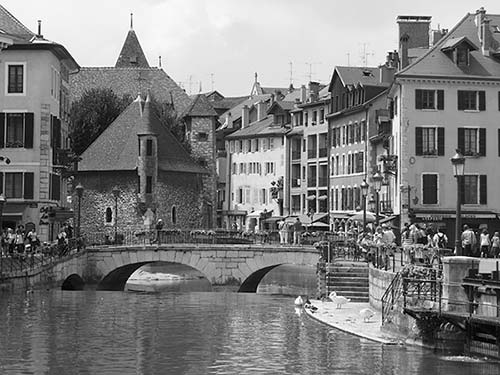
Modern Annecy (pop. 50,000) sprawls for miles, but we’re interested only in its compact old town, on the northwest corner of the lake (known as Lac d’Annecy, or Lake Annecy). The old town is split by the Thiou River (which looks more like a canal) and bounded by the château to the south, and the TI and Rue Royale to the north.
The TI is a few blocks from the old town, across from the big grass field, inside the Bonlieu shopping center (daily 9:00-18:30, some midday closures, Sun hours vary depending on season; 1 Rue Jean Jaurès, tel. 04 50 45 00 33, www.lac-annecy.com). Get a city map, the Town Walks walking-tour brochure (describes several themed walks and has basic historical information), the map of the lake showing the bike trail (and a good brochure about the bike trail), and, if you’re staying awhile, the Lac Annecy Magazine. Ask about walking tours in English (€6.50, July-Aug only, normally Tue and Fri at 16:00). There’s a handy WC across the hall from the TI. You’ll also find TIs in most villages on the lake (many open weekends and summers only).
By Train and Bus: The stations sit side by side. To reach the old town and TI, cross the street in front of the stations, turn left, and walk to the Hôtel des Alpes. Turn right on Rue de la Poste, then left on Rue Royale to reach the TI and some hotels, or continue straight to more recommended hotels. Baggage storage is available nearby (see “Helpful Hints,” later).
By Car: Annecy can be a traffic mess in high season and on weekends. Smart drivers plan to arrive early, during lunch, or late. Avoid most of the snarls by taking exit #16 from the autoroute (headed north, it’s signed Annecy-Centre; headed south, the sign reads Albertville). Avoid exit #17, the other Annecy option. From exit #16, follow Annecy/Albertville signs. Upon entering Annecy, follow signs to Le Lac or Le Château depending on the location of your hotel. (Don’t follow signs for Annecy-le-Vieux.)
Refer to the map of Annecy for parking lots. The first 30 minutes are free; after that figure €1.30 per hour (about €16/24 hours). Ask your hotel for a free overnight parking pass for the Hôtel de Ville or Bonlieu parking lots. Upon arrival, ditch your car at the first lot you come to, then get advice from your hotel for more convenient parking. Parking Ste. Claire and Parking du Château work for the hotels I list away from the lake. On the lake, you can park near the big boat docks at the underground Hôtel de Ville lot or at Parking La Tournette, or a block farther along at Parking Stade Nautique. If all else fails, the big Parking Trésum, just off the lake, usually has spaces. The Casino and Marquisats parking lots are free but a 15-minute walk to town.
By Plane: From Geneva’s airport (GVA, www.gva.ch), Annecy is a 45-minute autoroute drive (Swiss vignette required; see “Getting Around the Alps,” earlier). To get from the airport to Annecy sans car, take the airport bus (6/day Mon-Sat, 2/day Sun, www.gva.ch), book a shuttle van in advance (www.genevashuttle.com), take Ouibus (www.ouibus.com), or make the cheap but scenic 2.5-hour slog by bus and train (10/day). Taxis charge an outrageous 200 Swiss francs. Geneva’s airport has a helpful transportation desk at baggage claim.
From Lyon’s St-Exupéry airport (LYS, www.lyonaeroports.com), allow 1.5 hours by car (all autoroute), 2 hours by Ouibus (4/day), or 2.5 hours by train (8/day).
Market Days: A thriving outdoor food market occupies much of the old town center on Tuesday, Friday, and Sunday mornings until about 12:30. The biggest market in Annecy is on Saturday, but it’s less central and geared toward locals (more clothes, fewer crafts; until 12:30, around Boulevard Taine—several blocks behind the TI).
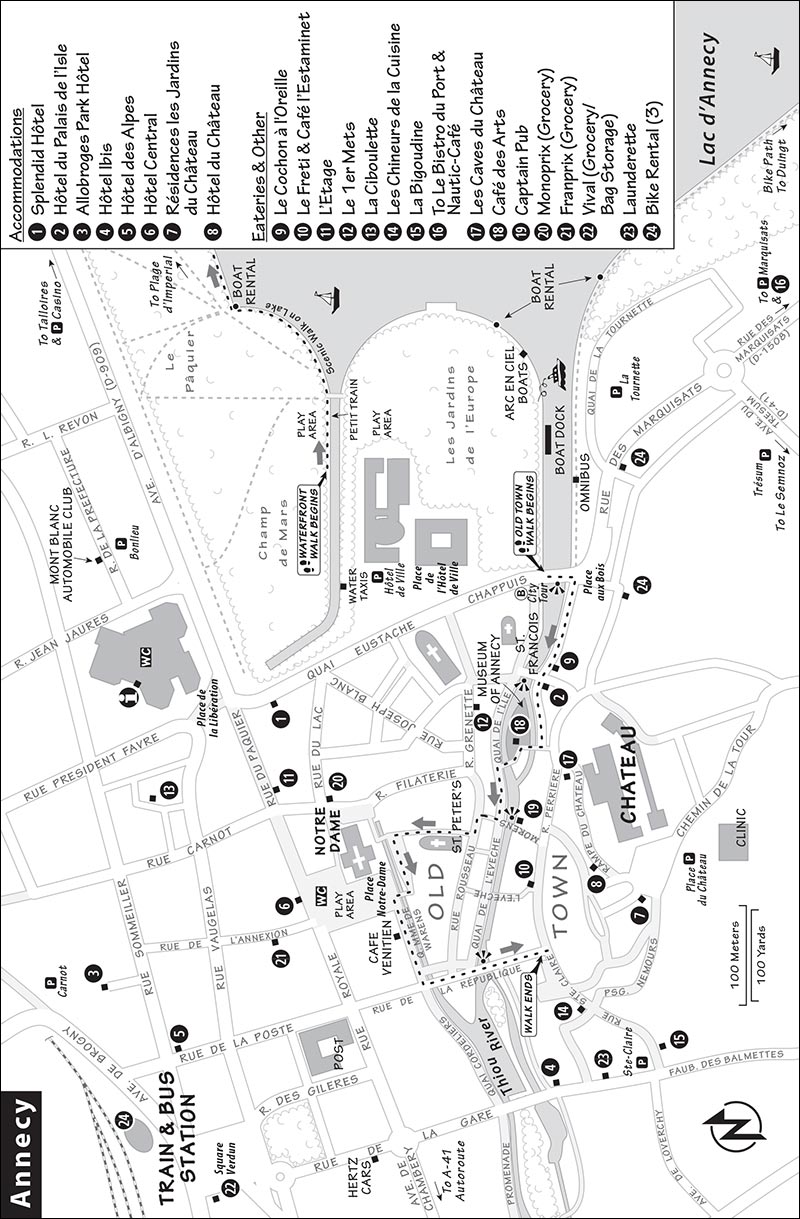
Supermarkets: The Monoprix is at the corner of Rue du Lac and Rue Notre-Dame (Mon-Sat 8:30-19:50, closed Sun, supermarket upstairs). A smaller Franprix is on Rue de l’Annexion just off Rue Royale (Mon-Sat 8:00-21:00, Sun 9:00-19:00).
Bike Alert: Pedestrians should be aware of bike riders and avoid walking in bike lanes. If you ride a bike here, obey the same rules you would when driving a car (look before merging, don’t stop in a travel lane, etc.).
Baggage Storage: Store your bags at the Vival grocery across from the train station (€3/hour, or €12/day, 1 Rue de l’Industrie, Mon 13:00-21:00, Tue-Sun 9:00-21:00, see the “Annecy” map). Bike renters can leave their bags at all bike-rental shops (except Véloncey).
Laundry: Lav’ Confort Express launderette is at the western edge of the old town near where Rue de la Gare meets Rue Ste. Claire (6:00-20:00, 6 Rue de la Gare).
Bike and Paddleboard Rental: Many places rent bikes for about €20/day (leave ID as deposit, includes helmet and basket, half-day rentals; electric, tandem, and kids’ bikes/carriers available; hours generally daily 9:00-12:30 & 14:00-18:30). All but Véloncey can keep your bags while you ride. Ask the TI about a rental shop near your hotel.
Roul’ ma Poule, near the lakefront bike path across from the lake steamers, rents rollerblades, bikes, and more (open March-Oct, 4 Rue Marquisats, tel. 04 50 27 86 83, www.roulmapoule.com). They also rent paddleboards (about €15/half-day) from their shop in Annecy-le-Vieux (47 Avenue du Petit Port, tel. 04 50 23 31 15). Cyclable is also near the lake on Place aux Bois (more choices, open daily 9:00-19:00, tel. 04 50 51 51 50, www.cyclable.com). Véloncey Bikes is at the train station and requires a €250 deposit (closed Sun, tel. 04 50 51 38 90).
Car Rental: Avis is at the train station (tel. 04 50 52 87 10). Hertz is a block from the station (15 bis Avenue de la Gare, tel. 04 50 51 19 89).
Taxi: Call 04 50 45 05 67.
Bus Tour: Red open-top minibuses run hour-long loops around the old town and along sections of the lake—an easy introduction to Annecy. Board the Annecy City Tour bus by the view bridge where the river enters the old town (€13, May-Sept 3-4 trips/day, some English commentary, see the “Annecy” map for bus stop, details at TI or www.annecycitytour.com).
Bad Weather: If it’s raining, consider a day trip to Lyon (10 trains/day, 2 hours, 6/day by bus, see “Annecy Connections” later). The last train back to Annecy usually leaves Lyon at about 21:00, allowing a full day in the big city.
Most of the old town is wonderfully traffic-free. The river, canals, and arcaded streets are made for ambling, as described in the TI’s Town Walks brochure (see “Tourist Information,” earlier). This 45-minute walking tour includes aspects of the TI’s walks and will get you familiar with Annecy toute de suite. Do it early to allow time for une pause café at a canalfront café, or do it in the evening so you can enjoy the old town’s soft lighting. No sight in Annecy merits an entry fee. Cool your jets and learn to saunter—as you wander Annecy’s lovely lanes you’ll be following in the footsteps of Jean-Jacques Rousseau, who adored strolling here (see sidebar).
Start in the center of the bridge on Quai Eustache Chappuis (it’s the bridge closest to the lake). With your back to the lake, take in the iconic view of the old town. You’re looking down the Thiou River, which starts its puny 2.2-mile trek here (running from the lake into tributaries of the Rhône River). It splits the old town in two and has provided power and resources for Annecy’s economy since the Middle Ages. The Museum of Annecy (Palais de l’Isle) covers the tiny island in the river straight ahead, the St. François de Sales Church (1610) sits to your right, and the château (built in 1219, described later) looms above to the left.
Stroll down the left side of the river toward the island. You’ll soon spot twin metal gates allowing overflow from the Thiou to pass under the St. François de Sales Church and into the St. Dominique Canal. The pretty church was converted into a textile factory after the Revolution (and became a church again in 1923).
Keep straight along the river at the first bridge, skirting past the Museum of Annecy, and then cross onto the minuscule island at the next bridge. You’ll pass the I-could-stay-a-while Café des Arts (opens at 10:00) and the entrance to the museum (described later).
Resume your walk by crossing to the other side of the Thiou and turn left on Quai de I’lle. Notice the homes with doors right at river level. The river is carefully controlled with overflow gates and locks to maintain its level, allowing it to run safely through the heart of the city. At the next bridge (Pont Morens), look for the protruding outhouse on the upper floor of the building across the canal. This bridge was smothered with houses in the Middle Ages, when a central address was all-important and any available space was used for housing.
Turn your back to the canal and walk under those heavy arches, then make a left onto Rue J. Jacques Rousseau. You’ll come to Annecy’s plain St. Peter’s Cathedral (built in 1535, and used by the Counts of Geneva during the Reformation). Turn right just before the cathedral on Passage de la Cathédrale, then make a left at the canal and walk to the next bridge. Notice the merging of two canals and wooden walkways. The canal running under the building is the Notre Dame Canal; the other is the Vassé Canal (both were instrumental in Annecy’s economic development). Cross the bridge, take a short detour into the big square, Place Notre-Dame, to admire the flowers, then double back and continue along the canal. Consider a canalfront pause at the peaceful Café Vénitien (open daily at 8:00).
Continue on and turn left when you reach Rue de la République. When you get back to the Thiou River, stop on the bridge to take in the view over Quai de l’Evêché. Those metal gates (on either side of the bridge) once fed water to a turbine that powered a cotton factory in the late 1800s. Continue along Rue de la République, returning to the lake by taking a left along the arcaded and pedestrian-popular Rue Ste. Claire. Any lanes to the right lead up to the Château Museum (described later).
This serenely situated 13th-century building cuts like the prow of a ship through the heart of the Thiou River. Once a prison, it held captured French Resistance fighters during World War II. Today, you can still see several of the prison cells, but most of the museum is taken up with exhibits on local architecture since the war and is skippable.
Cost and Hours: €4, €7.20 combo-ticket includes Château Museum, Wed-Mon June-Sept 10:30-18:00, Oct-May 10:00-12:00 & 14:00-17:00, closed Tue year-round, free English leaflet.
The castle, built in 1219 by aristocrats from nearby Geneva, reminds us of the historic and important ties Annecy had with its big sister city. The castle itself cuts an impressive figure as it hangs above the lake in the old town. But there’s little to see inside: a few rooms devoted to local folklore, anthropology, and natural history, and a modern-art collection that rotates regularly. Skip it.
Cost and Hours: €5.50, €7.20 combo-ticket with Museum of Annecy, same hours as Museum of Annecy.
Stroll the bike/walking path in either direction for lake and mountain views. The best views are found walking east with the lake on your right. The peaks of Mont Veyrier and La Tournette dominate the left (east) side of the lake while Le Semnoz and the tallest viewable peak—La Sambuy at 7,200 feet—control the west and south views. A petit tourist train runs along the lake from near the small Pont des Amours to the Imperial Palace Hotel and beach (in good weather only, 2/hour, €4 one-way, €6 round-trip, see “Annecy” map for departure point).
Annecy’s lake is ringed with good beaches offering great swimming and views. Some are private and charge a small fee, others are free. Most have grassy shores. Plage d’Imperial offers the most kid fun, with water slides and more (small fee, served by the tourist train, www.plage-imperial.com). A bit past Plage d’Imperial, Plage d’Albigny is a good, sandy public beach but also draws lots of people in summer (free). Plage Municipale de Sevrier, 10 minutes from Annecy, is a sandy beach with great views on the lake’s bike path (free).
Lakeside paths and short, steep hikes up hillsides offer rewarding views, even with clouds. Boats, bikes, and cars make this lake’s villages, hikes, and views accessible. Here are a few suggestions for where to go around the lake.
This is one of Europe’s cleanest, clearest lakes, and the water is warmer than you’d think (average summer water temperature is 72 degrees Fahrenheit).
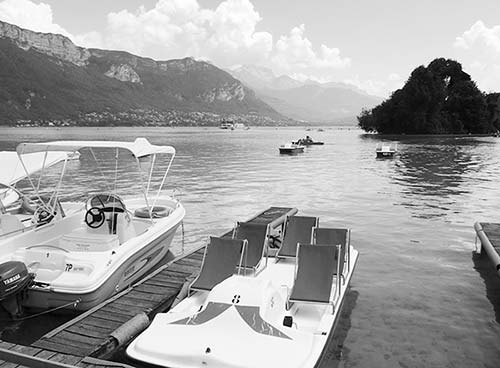
On Your Own: To tool around the lake, rent a paddleboat (pédalos, some equipped with a slide, about €20/hour for 2 people; some boats can handle 6 passengers) or a motorboat (hors-bord, no license needed; about €60/hour for 2 people, up to 7 people, several companies all have the same rates). Water taxis will take you for a personal cruise or to destinations along the lake such as Talloires or Duingt (figure €140/hour for up to 5 passengers for a cruise, mobile 06 28 06 74 87, info@water-taxi.fr).
Organized Cruises: Compagnie des Bateaux du Lac d’Annecy runs several worthwhile lake cruises. The one-hour cruise makes no stops but has frequent departures (€14.50, 8-10/day May-Aug, 6-8/day April and Sept-mid-Oct, generally 1/day off-season, no cruises in Jan). The two-hour cruises, called Circuit Omnibus, stop at several villages on a clockwise loop around the lake and allow one stopover—Duingt or Talloires, described later, are good choices (€19 for entire loop, less for shorter trips, 3-5/day late April-Sept); these are ideal for hikers and cyclists (see later). Another boat offers 2.5-hour lunch cruises for about €60 and elaborate dinner and dancing cruises (€60-90). Get schedules and prices for all boat trips at the TI or on the lake behind Hôtel de Ville (tel. 04 50 51 08 40, www.annecy-croisieres.com). Yet another company, L’Arc en Ciel, runs lake cruises in smaller boats (with some commentary) at similar prices (www.arcenciel-annecy.com).

Annecy was made for biking. It’s an ain’t-it-great-to-be-alive way to poke around the lake (sun or clouds) and test waterfront cafés and grassy parks and beaches. A scenic lakefront bike trail runs along the entire west side of the lake. Even a short ride on the path is worth the effort, as there are no hills, you’re separated from car traffic, and the lake and mountain views make you forget the hard seat. Expect big crowds on weekends. Wear sunglasses and bring water and a bathing suit.
Leave Annecy passing right by the big boats with the lake on your left, pedal as far as your legs take you, break for a lakefront café, and consider a swim at one of the many grassy beaches. You’ll pass wheat fields, farms, towns, and lots of other riders (treat the trail like a highway—merge carefully, don’t stop in your lane, etc.). My favorite easy ride is the seven-mile stretch from Annecy to the village of Duingt (described later)—steady pedalers make it in 45 minutes; smell-the-roses types need an hour. You can ride to Duingt and take your bike on the Circuit Omnibus boat back to Annecy (not recommended mid-July-mid-Aug, when boats are most crowded), or vice versa (€11, 3/day from Duingt, 45 minutes; generally at 11:45, 15:30, and 18:00; more departures in summer, verify at boat dock or TI). Riding 20 minutes past Duingt to the lake’s southern end at Doussard brings some of the best lake views (Circuit Omnibus boat stops here, one-hour trip back to Annecy). Serious cyclists can make it around the lake in about 3-4 hours (be prepared for narrow roads on the stretches with no bike path, and a few steep hills on the other side of the lake).
Brake for a Break: About 15 minutes after leaving Annecy you’ll come to L’Oasis/Auberge de Bessard chalet/café, an inviting Shangri-la kind of place (serves smoothies, coffee, beer, salads, and complete meals; daily March-Oct from about 9:00). In another 10 minutes you’ll pass the peaceful, low-key Nautic-Café, with a few tables at the water’s edge (cheap coffee and beer, daily from 9:00). It’s in Sevrier’s marina: Turn left when you see the wood slat building on your left marked Cercle de Voile/Club Kayak.
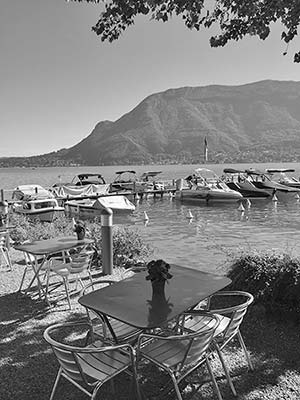
The quiet village of Duingt is a good destination by boat (see “Organized Cruises,” earlier) or bike from Annecy. Here you’ll find a café, bakery, tiny boat dock, and a good hike (see below). Bike riders exit the trail just before the rail tunnel, cross under the trail, and turn right (for the village center and the hike). If you arrive by boat, walk through the park with the lake on your right, and cross into the village. By car it’s a 20-minute drive from Annecy. Park behind Duingt’s church and walk along the asphalt lane past the little TI (open summers only) and the old rail tunnel (now the bike path).
Duingt’s boulangerie sells good sandwiches, quiches, and drinks and is on the lakefront road, 50 yards toward Annecy from the Hôtel du Roselet. The small park between the castle and the boat dock has picnic tables and views.
Hike: A short, steep, and beautiful trail leading up to glorious lake views starts from the rear of the village (100 yards from the old rail tunnel toward the town center). Find signs to Grotte N-D du Lac Belvedere, and walk up the trail passing the Stations of the Cross. In another 20 minutes, great views and benches await at the end of the paved walkway. From here, a steep dirt trail continues up for even better vistas (some rocky, uneven sections).
From this upscale and charming village, you can hike (and I mean hike) along the Roc de Chère trail up to jaw-dropping views over the village and Lake Annecy. To reach Talloires from Annecy, allow 30 minutes by car, 45 minutes by Circuit Omnibus boat (and 90 scenic minutes back as the boat does a one-way loop around the lake). The lack of bike paths makes Talloires a less appealing bike trip.
Those arriving by car can avoid the steep hike up the Roc de Chère trail by turning at signs for the Golf du Lac d’Annecy golf course between Menthon-St-Bernard and Talloires—you’ll soon find hiking signs by the wood shelter (parking available). It’s a 20-minute walk from there to the lake views.
If coming by boat, plan on about two hours for the hike. Walk from the Talloires dock, veering left up and up through the quaint village to the main road (D-909). Turn left on the road and follow the narrow sidewalk. A few minutes after passing Chalet Christine, find the short staircase leading left into the trees (after the hairpin curve). The trail climbs for 20 extremely steep minutes up a rocky path with some very uneven footing. You’ll pass a map of the area’s trails and come to benches with glorious views. Follow Liaison Menthon-St-Bernard signs to continue to that village (and catch the Circuit Omnibus boat there), or double back to Talloires.
You could hike the Roc de Chère trail from Menthon-St-Bernard’s boat dock, but finding the trail takes patience: Turn right off the boat, walk to the big hotel/palace, turn left and walk 200 yards up the road, then take a right on a path marked Roc de Chère. This leads to a small road (turn right again), taking you up to the trail. If you need lunch in Talloires, find $$ Café de la Place (daily, tel. 04 50 64 40 74).
The busy roads that link villages along the lake (D-1508 on the west side and D-909 on the east) deliver mostly modest, though occasionally spectacular, lake views (better from D-909). They eventually lead to a scenic route to Chamonix and access to fantastic view drives (described next). Read the bike route description earlier for suggested stops along the lake’s west side. Be prepared for afternoon traffic on weekends and on any day in summer.
Several roads off D-1508 and D-909 lead to remarkable views of this gorgeous area. Go early for clearest skies, go late for sunsets, and skip it if it’s hazy. Both views below are worth ▲▲ in clear weather.
Le Semnoz: For majestic mountain panoramas near Annecy that include Mont Blanc, drive or take the summer-only bus up...and up...and up to Le Semnoz (about 5,000 feet). To drive, follow D-41 from near the lake (see the “Lake Annecy” map). Allow about 30 minutes one-way and expect lots of bicycles on weekends. After leaving the city, you’ll pass through Annecy’s forest and climb past tree level to grandiose views over the high Alps, featuring Monsieur Blanc. Just before the top, you’ll pass a fun summer luge (Luge d’Eté, about €4/ride in summer, July-Aug daily; May-June and Sept-Oct Wed, Sat-Sun, and holidays). Carry on, climbing above the luge area, pass the hotel, and park when you see the chalet-café Le Courant d’Ere (good for a drink and snacks, but meals are mediocre; open daily for lunch, tel. 04 50 01 23 17). Climb to the chairlift station above the café for a magnificent panorama in all directions. Ligne d’Eté buses to Le Semnoz (and this viewpoint) leave from the Annecy train station (€6 round-trip, 6/day, daily July-Aug, Sat-Sun only in June, none Sept-May, 40 minutes, stops at the luge, details at TI and www.sibra.fr).
Col de la Forclaz: For drop-dead gorgeous views that take in the entire lake, drive 18 miles from Annecy (allow 45 minutes one-way) to Col de la Forclaz. Start by taking D-1508 south toward Albertville. Three kilometers (about one mile) after leaving the lake at Doussard, turn left on D-42 (signed Col de la Forclaz), then wind your way up a narrow lane for five miles past lovely scenery to the Col de la Forclaz (3,600 feet). Look out for cyclists on this climb. At the top, you’ll find a sensational viewpoint, cafés and restaurants, and paragliders galore. Several outfits offer a chance to jump off a cliff and sail over the lake, including the appropriately named Adrenaline Parapente (www.annecy-parapente.fr). This trip ties in well with the scenic route to Chamonix via D-1508; it also works as a loop back to Annecy (follow D-42 down to Menthon-St-Bernard from the Col de la Forclaz).
Annecy is popular, particularly on weekends and during the summer. Hotel rates drop from about mid-October through late April and increase in summer. Most hotels can help you find free overnight parking (in lots, usually after 19:00 until 9:00 in the morning). Unless otherwise noted, these hotels do not have elevators.
This part of town is pedestrian-friendly and comes with some noise.
$$$ Splendid Hôtel*** decorates Annecy’s busy, parkfront street and makes an impression with its grand, American-style facade and comfy public spaces inside. Standard rooms are tight but quiet and well-appointed; ask about larger accommodations and the pricier fifth-floor rooms with nice decks and lake views (air-con, elevator, big beds, bar, terrace, fitness room, 4 Quai Eustache Chappuis, tel. 04 50 45 20 00, www.splendidhotel.fr, info@splendidhotel.fr).
$$$ Hôtel du Palais de l’Isle*** offers a romantic canalside location in the thick of the old town and 34 contemporary rooms—several with canal or rooftop views—and a comfy lounge (air-con, elevator, 13 Rue Perrière, tel. 04 50 45 86 87, www.palaisannecy.com, contact@palaisannecy.com).
$$ Allobroges Park Hôtel,*** near the train station, rents lovely rooms in a handsome mansion set off the street (RS%, small terrace, great breakfast, air-con, elevator, easy pay parking, 11 Rue Sommeiller, tel. 04 50 45 03 11, www.allobroges.com, info@allobroges.com).
$ Hôtel Ibis*** is a good choice, with updated, well-configured rooms (all with queen-size beds), a canalside lounge, and access to underground public parking. It’s well-situated on the edge of the old town, a few blocks from the train station (air-con, elevator, 12 Rue de la Gare, tel. 04 50 45 43 21, https://ibis.accorhotels.com, h0538@accor.com).
$ Hôtel des Alpes,** a top value, has a homey feel with 32 pleasant rooms at a busy intersection a block from the train station. Rooms on the courtyard are quieter, but those facing the street have effective double-pane windows (family rooms, air-con, 12 Rue de la Poste, tel. 04 50 45 04 56, www.hotelannecy.com, info@hotelannecy.com).
$ Hôtel Central is just that and more. Run by your Annecy mother, Corinne, this modest, homey, and hyperdecorated place makes a fun stay. Each well-maintained room has a different theme, from Sevilla to India. It’s at the back of a modest, ivy-covered courtyard (family rooms, 6 bis Rue Royale, tel. 04 50 45 05 37, hotelcentralannecy@orange.fr).
These places are in a quiet area a steep five-minute walk up from the old town on Rampe du Château.
$$ Résidences les Jardins du Château, run by charming Austrian Martina and French Hervé, is an urban refuge above the fray near the château entry. It has a small garden and a picnic-perfect upstairs terrace, along with eight simple but good-enough rooms. No phones or TVs, but most rooms come with kitchenettes (good family rooms, cash only, 1 Place du Château, mobile 06 67 91 94 23, www.jardinduchateau.sitew.com, rent74@free.fr).
$ Hôtel du Château,** an unpretentious place run by unpretentious Romain and Amélie, sits barely below the château. It comes with a view terrace (nice for breakfast) and 16 simple, deep yellow, spotless rooms—about half have views. It’s first-come, first-get for the few free parking spots (rental bikes available, 16 Rampe du Château, tel. 04 50 45 27 66, www.annecy-hotel.com, hotelduchateauannecy@gmail.com).
Although the touristy old town is well-stocked with forgettable restaurants, I’ve found a few worthy places. And though you’ll pay more to eat with views of the river or canal, the experience is uniquely Annecy. The ubiquitous and sumptuous gelati shops remind me how close Italy is. If it’s sunny, assemble a gourmet picnic at the arcaded stores and dine lakeside.
$$ Le Cochon à l’Oreille (“The Pig’s Ear”) is a meat lover’s nirvana. Just off the Thiou River, it welcomes diners with a leafy courtyard and a raucous, higgledy-piggledy interior. Amicable owners “Fred” and Jean speak enough English (and fluent pig) and are serious about their cooking (ask to see their pig collection). The accent is on fresh products and meat dishes (particularly ham and pork), though fish options are available. Melted cheese is not their thing (huge salads, good-value two-course meal, closed Mon, Quai du Perrière, tel. 04 50 45 92 51).
$$ Le Freti is a reliable restaurant for local cuisine at fair prices. It’s the place to go for good fondue, raclette, or anything with cheese. There’s fine outside seating under the arcade, and inside upstairs, where each booth comes with its own outlet for melting raclette (reservations smart, but not taken in summer—arrive early or expect a long wait, cheap wine, air-con, open daily for dinner, open for lunch weekends only in off-season, walk through door at 12 Rue Ste. Claire and go upstairs, tel. 04 50 51 29 52, www.lefreti.fr).
$$ Café l’Estaminet, a pub-like place with a cozy interior and a few waterside tables on the back terrace, dishes out salads, omelets, pasta, mussels, fries, and more for fair prices (daily in summer, off-season closed Sun evening and Mon, 8 Rue Ste. Claire, tel. 04 50 45 88 83).
$$ L’Etage is a good choice if you can’t decide what you want. Well-prepared regional specialties and a good range of standard brasserie fare are served at respectable prices. Dine along the pedestrian street terrace or upstairs under wood beams around a big fireplace (fondue and raclette, daily, 13 Rue du Paquier, tel. 04 50 51 03 28).
$$ Le 1er Mets is made for foodies. It’s an intimate, contemporary place with a focus on preparation, presentation, and service. The cuisine offers a little of everything, from rabbit to octopus (book well ahead, 2 Place Saint-Maurice, tel. 04 57 09 10 54, www.restaurant-1ermets.fr).
$$$ La Ciboulette is a lovely splurge. Dine with class without breaking the bank at a Michelin-starred restaurant on the terrace or in the lovely dining room (menus from €40, daily, 10 Rue Vaugelas, tel. 04 50 45 74 57).
$$ Les Chineurs de la Cuisine is a nice place for a refined meal in the thick of the atmospheric Faubourg Ste. Claire area. Locals come here for French and regional classics. The interior mixes nostalgic knickknacks and fine dining ambience; outdoor tables are few and need to be booked ahead (daily, 26 Rue Ste. Claire, tel. 04 50 10 02 18, www.chineursdelacuisine.com).
$ La Bigoudine has been serving simple and cheap savoyard specialties for more than 20 years. It’s a great budget value, with a modest-yet-cheery, two-level interior and good outside tables (closed Wed except in summer, 15 Faubourg Ste. Claire, tel. 04 50 51 31 22).
Lakefront Dining: Many cafés and restaurants ring Annecy’s postcard-perfect lake. If you have a car and want views, prowl the many waterfront villages. $$$ Le Bistro du Port, a nautical place five minutes from Annecy by car, is beautifully situated on the boat dock at the southern end of Sévrier-Centre (daily, Port de Sévrier, turn off D-1508 at the McDonald’s, tel. 04 50 52 45 00).
Dessert: Wherever you eat, don’t miss an ice cream-licking stroll along the lake after dark.
Nightlife: Start or end your evening at one of these local and different-as-night-and-day places. At the cozy wine bar Les Caves du Château, you’ll escape the crowds by heading just 20 steps up the Rampe du Château from busy Rue Ste. Claire. They offer a good choice of wines by the glass from throughout France and appetizers (daily except closed Mon Sept-June, 6 Rampe du Château, tel. 09 51 17 29 98).
Café des Arts is Annecy’s most atmospheric café, marooned on the island at the Palais de l’Ile. With good prices, it attracts a mix of local hipsters and the odd tourist (daily 10:00-late, 4 Passage de l’Isle, tel. 04 50 51 56 40).
At the Captain Pub (arrr, matey!) you’ll step down into a venerable pirate’s pub deep in Annecy’s old town. Half the place works as a $$ restaurant with nice seating inside and out, the other half is the pirate’s den pub (open 11:00-late, 10 beers on tap, 50 more in bottles, 11 Rue du Pont Morens, tel. 04 50 45 79 80).
Check Ouibus (www.ouibus.com) and Flixbus (www.flixbus.com) for cheaper fares and sometimes better schedules.
From Annecy by Train or Bus to: Chamonix (train: 10/day, 2.5 hours, change in St-Gervais; bus: 5/day by Ouibus, 2 hours), Lyon (train: 10/day, 2 hours; bus: 6/day by Ouibus and Flixbus, 2.5 hours, some stopping at Lyon airport and Lyon-Perrache), Beaune (8/day, 4 hours, change in Lyon), Nice (4/day, 7 hours, start with bus or train to Lyon, more with 2-3 changes), Paris’ Gare de Lyon (hourly, 4 hours, many with change in Lyon), Geneva (about hourly, 2 hours by bus/train; bus-and-train options also available from Geneva’s airport in 2.5 hours).
Surrounded by snow-capped peaks, powerful—if receding—glaciers, and richly rewarding hiking trails, Chamonix (shah-moh-nee) is France’s favorite alpine resort. Officially called Chamonix-Mont Blanc, it’s the largest of five villages lining the valley at the base of Mont Blanc. Ever since tourists eclipsed cows as the town’s economic base a couple hundred years ago, Chamonix’s purpose has been to dazzle visitors with some of Europe’s top alpine thrills. But you’ll also learn a thing or two about glaciers and get a look into the wild world of mountain climbing. Chamonix is a busy place from early July through late August and during winter holidays, but it’s plenty peaceful at other times. Chamonix’s sister city is, logically, Aspen, Colorado.

Summers—or any time a sunny day follows a rainy stretch—bring crowds and long lift lines. Ride the lifts by 8:00 (crowds and clouds roll in later in the morning).
If you’re a good hiker and have one sunny day, spend it this way: Start with the Aiguille du Midi lift (go very early, reservations possible and recommended July-Aug), take it all the way to Pointe Helbronner, double back to Plan de l’Aiguille, hike to Montenvers and its Mer de Glace (with good shoes and snow level permitting), explore there, then take the train down to Chamonix. End your day with a well-deserved drink at a view café in town.
If you can’t get to Helbronner and have a Multipass lift ticket (described later), do the Aiguille du Midi and the walk to Montenvers, return to Chamonix and take the Le Brévent gondola to Planpraz. Find a seat at one of several magnificent view cafés and watch the parasailers launch into the abyss.
The frothy Arve River splits Chamonix in two—with mountains (Mont Blanc and the Aiguilles Rouges peaks) towering on either side. The thriving pedestrian zone forms Chamonix’s lively core. The TI is just above the pedestrian zone, and the train station is two long blocks across the river. To get your mountain bearings, head to the TI and find the big photo in front. And to see the town, follow my self-guided Chamonix Walk (described later) from that point.
Located where Switzerland, Italy, and France intersect, this town has always drawn an international crowd. Today about half of its foreign visitors are British—many have stayed and found jobs in hotels and restaurants.
Visit the TI to make plans. Get the mountain weather forecast, pick up the free town and valley map and the “panorama” map of all the valley lifts, and maybe the €5 Carte des Sentiers hiking map (see “Chamonix-Area Hikes” on here). Ask about snow levels and hours of lifts and trains, and consider buying the Multipass lift ticket (described later). The TI’s helpful website and free app have updated sightseeing info, weather forecasts, and more (daily mid-June-mid-Sept and mid-Dec-mid-April 9:00-19:00; off-season generally Mon-Sat 9:00-12:30 & 14:00-18:00, closed Sun; tel. 04 50 53 00 24, www.chamonix.com, info@chamonix.com). Pull up a beachy sling chair outside the TI and plan your hike.
By Train: Walk straight out of the station and up Avenue Michel Croz. In three blocks, you’ll reach the town center; turn left at the big clock, then right for the TI. While the train station has no baggage storage, you can leave bags at the Absolute Café/Tabac shop (a block in front of the station on the right at 223 Avenue Michel Croz, €5/5 hours, €1/hour after that).
By Bus: The long-distance bus station is south of the town center (234 Avenue de Courmayeur, behind the bowling alley). It’s a 15-minute walk to the town center (see the “Chamonix Town” map). Or take the free shuttle bus called Le Mulet (see here).
By Car: For many of my recommended hotels and the TI, take the Chamonix Nord turnoff—coming from Annecy and Geneva, it’s the second exit after you pass under the Aiguille du Midi cable car—and follow signs to Centre-Ville. Take the exit before the Aiguille du Midi lift station for hotels south of the TI. Most parking is metered and well-signed; your hotel can direct you to free parking. From mid-July to late August, traffic and parking are a mess in Chamonix—plan ahead or arrive before 10:00 to get a spot.
The Mont Blanc tunnel (7.2 miles long, about a 15-minute drive) allows quick access between Chamonix and Italy (one-way-€46, round-trip-€58 with return valid for 1 week, www.tunnelmb.com).
By Plane: The nearest international airport is in Geneva, Switzerland (Genève airport, airport code: GVA, www.gva.ch; hourly trains, 4 hours with two changes; 2 hours by car, airport shuttle van, or bus—see “Chamonix Connections” at the end of this chapter. Also nearby is Lyon (St-Exupéry airport, airport code: LYS, www.lyonaeroports.com; linked by 6 trains/day, 4 hours; 4 buses/day, 3.5 hours on Ouibus; 3 hours by car).
Crowd-Beating Tips: Trails are quieter the earlier you go. The only lift with serious crowd challenges is the big one: Aiguille du Midi. In high season (especially on a good day after a stretch of bad weather), take an early lift to beat the crowds and afternoon clouds (lift opens at 6:30 or 7:00 in summer, go no later than 8:00). Have breakfast on top.
Regardless of the weather, good restaurants in Chamonix can be booked solid for summer evenings. It’s smart to make reservations.
Plan Ahead: Bright snow abounds up high, so bring sunglasses and dress for the cold. For Chamonix’s weather, check at your hotel, the TI, or online at www.chamonix.com or www.chamonix-meteo.com. For current lift information and to book the Aiguille du Midi lift, use www.montblancnaturalresort.com (select “Area & Sites,” then “Aiguille du Midi”).
Open-Air Market: Chamonix’s Saturday-morning market fills big Place Mont Blanc.
Supermarkets: Little Casino markets are plentiful. The Super-U is central and big (next to Le Génépy on Rue Joseph Vallot). Supplement your run-of-the-mill groceries with gourmet local specialties from Le Refuge Payot (two locations: 166 Rue Joseph Vallot and 255 Rue du Docteur Paccard).
Inexpensive Mountain Gear: The best deals on sunglasses, lightweight gloves, daypacks, and the like are at Technique Extrême (daily 9:00-19:00, 200 Avenue de l’Aiguille du Midi).
English Books: Small collections are kept at Librarie Landru (open daily, 74 Rue Joseph Vallot) and at Maison de la Presse (daily, 93 Rue du Docteur Paccard).
Laundry: There are two good self-service launderettes, both with long hours daily: One is a block up from the Aiguille du Midi lift at 174 Avenue de l’Aiguille du Midi; the other is in the Blanche Neige Gallerie on 266 Rue du Docteur Paccard, across from Le Refuge Payot.
Taxis: There’s usually one at the train station. If not, try Alp Taxi (mobile 06 81 78 79 51, www.alp-taxi.com) or Taxi Michel Buton (mobile 06 07 19 70 36, www.taxi-buton-chamonix.com).
Car Rental: Europcar is across from the train station (Mon-Sat 9:00-12:00 & 14:00-18:00, closed Sun, 36 Place de la Gare, tel. 04 50 53 63 40, mobile 06 85 40 04 72).
Local Guides: Local guides can be hired through the TI or the local guides bureau (half-day in English-€200, full day-€300, visitechamonix@hotmail.fr).
Local Firewater: Pick up a little (5 cl) bottle of génépi liqueur, the local herb schnapps, and nip on it throughout your high-altitude adventures. It’ll warm you and make you feel like a local.
Lifts and cogwheel trains are named for their highest destination (e.g. Aiguille du Midi, Montenvers, and Le Brévent). More details on individual lifts are given under “Sights in Chamonix,” later. You can find current lift information and book the big Aiguille du Midi lift at www.montblancnaturalresort.com. You can also buy tickets (and reserve the Aiguille du Midi lift) at any of the valley lift stations.
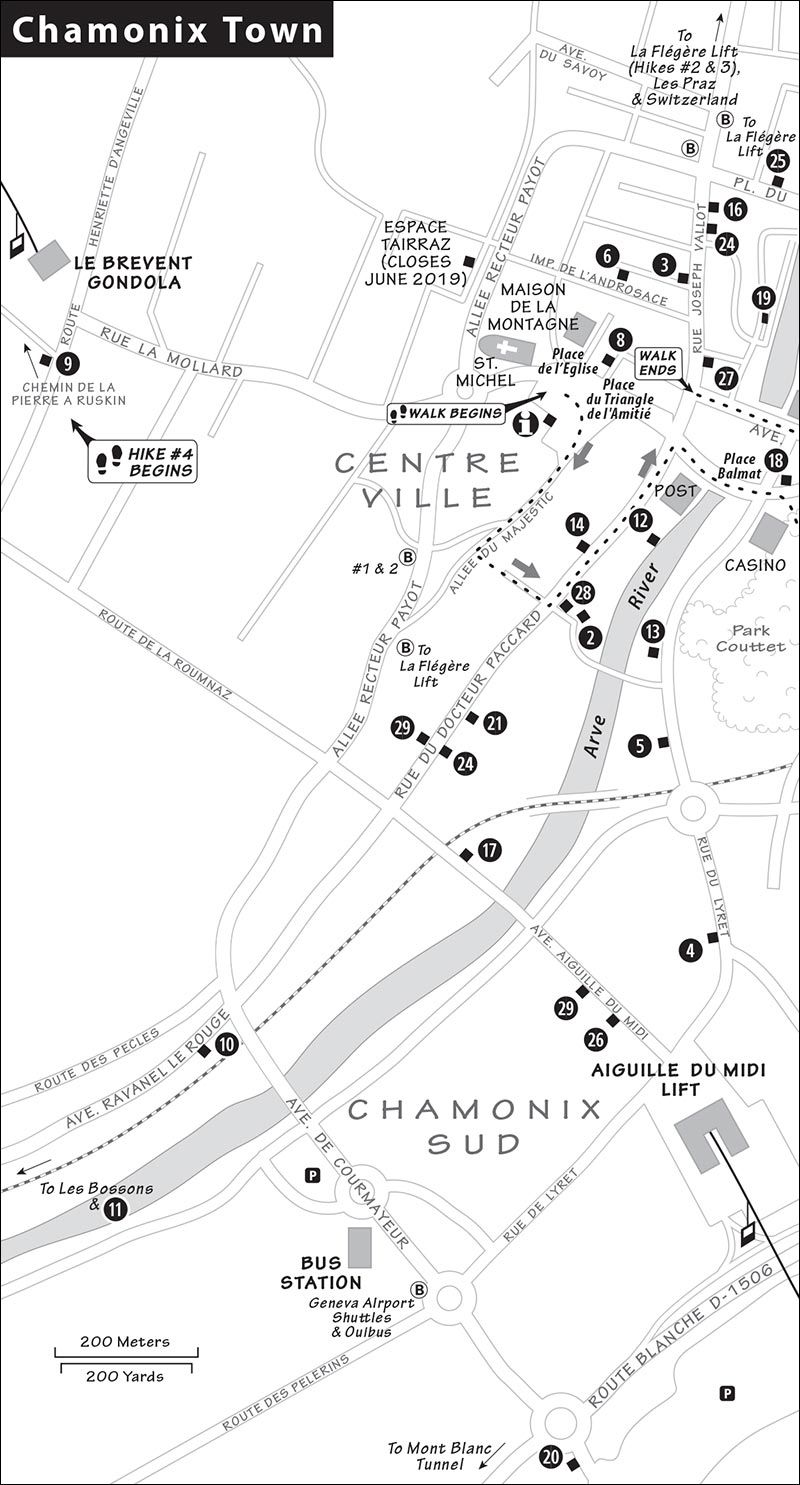
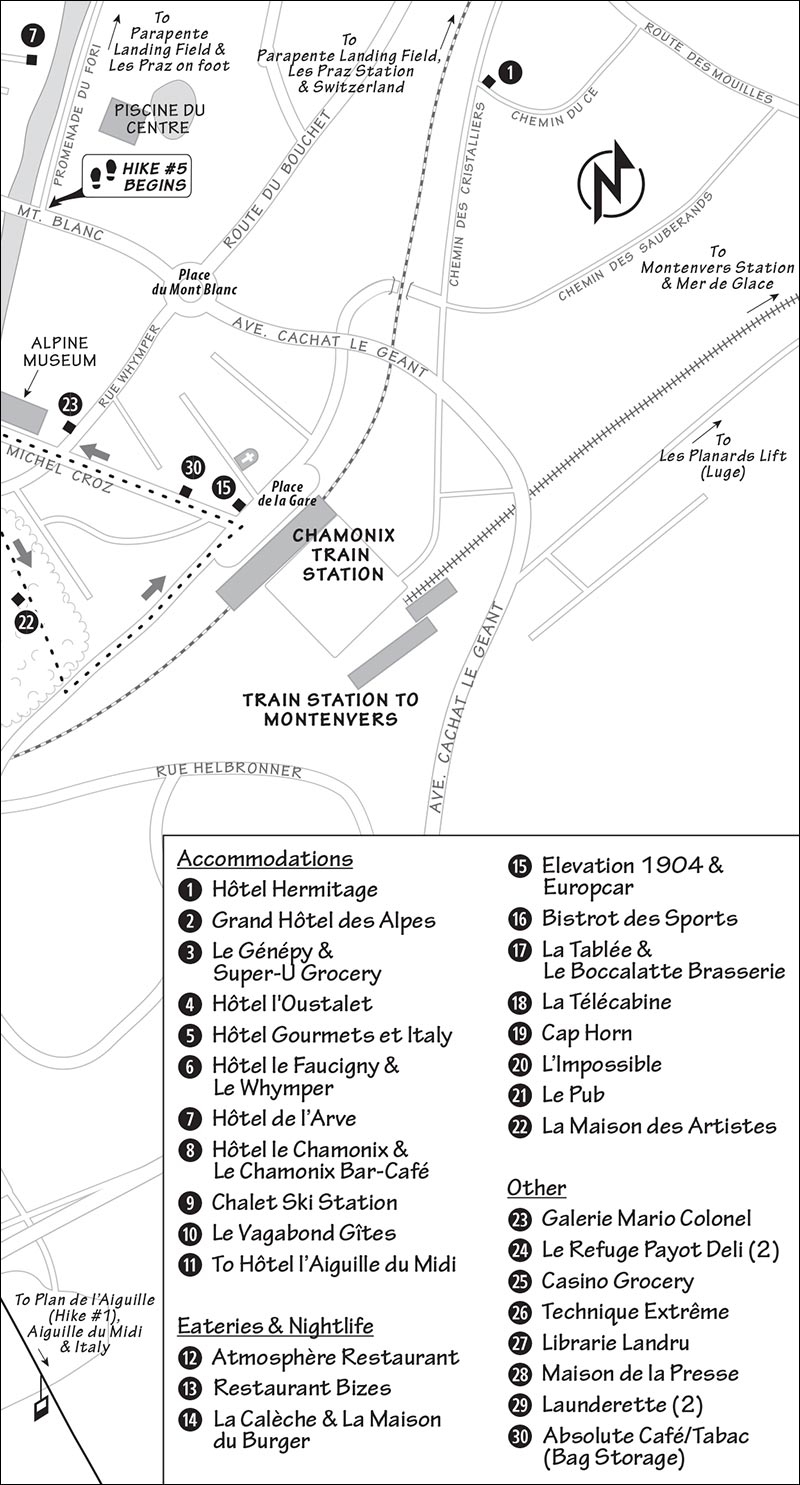
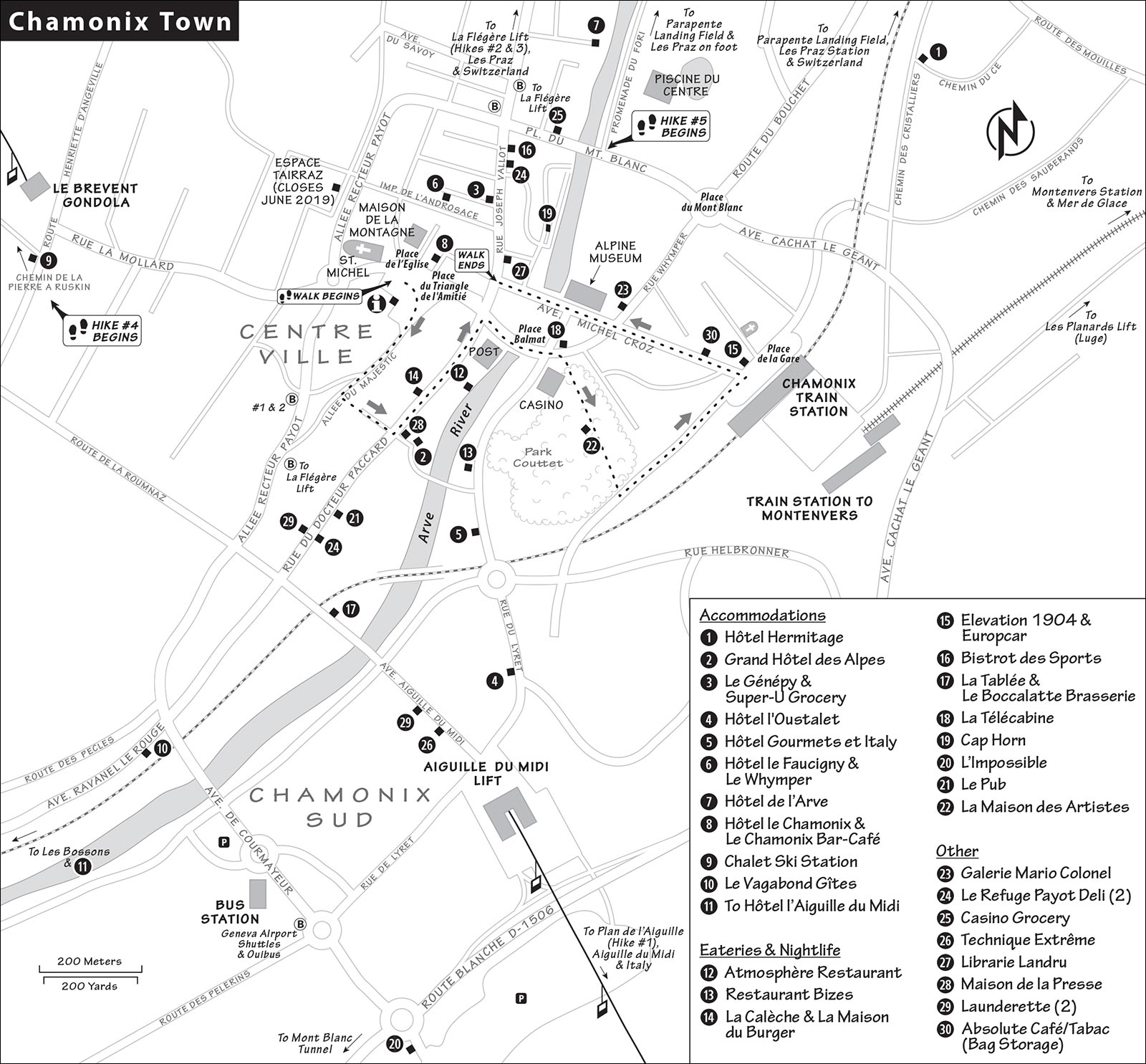
By Lift: Gondolas (téléphériques) climb mountains all along the valley. The mightiest one—Aiguille du Midi—leaves from Chamonix. Though sightseeing is optimal from the Aiguille du Midi gondola, there are more hiking options from the Le Brévent gondola and La Flégère lift.
The lift to Aiguille du Midi is open summer and winter (usually closed Nov-mid-Dec). The télécabines on the Panoramic Mont Blanc lift to Helbronner (atop the Italian border) run only from late June to early September, and even then only in good weather. The lift called Skyway Monte Bianco (on the Italian side of the mountain) runs from Helbronner down to Pontal d’Entrèves and rotates 360 degrees for panoramic views en route.
Other area lifts are generally open from January to mid-April and from mid-June to late September. Because maintenance closures can occur anytime, verify schedules for all lifts at the TI.
The Multipass lift ticket saves time and money for most, particularly if you’re spending two or more days in the Chamonix valley. It allows unlimited access to all the lifts and trains (except the Helbronner gondola to Italy). You also get discounts for various activities in Chamonix, such as the Parc de Loisirs des Planards.
Your pass is a smart card, valid for the day (not 24 hours). With it you can scan your way to the top and ride lifts you’d otherwise skip. You could hop on a lift just to have a drink from a view café at the top (€64/1 day, €78/2 days, €88/3 days, €128/6 days, add €3 to all passes for card itself; kids 4-14—and kids over 64—pay about 15 percent less for two-day and longer passes, kids under 4 may not be allowed). The one-day pass is only a few euros more than the round-trip ticket to Aiguille du Midi, and a terrific value if you plan to do the round-trip lift from Chamonix to Aiguille du Midi plus the round-trip train from Chamonix to Montenvers (and not hike between the two), and/or ride the Le Brévent gondola (great for view cafés and hikes). Families benefit from reduced fares. The pass is sold online (www.montblancnaturalresort.com), at participating lift stations, and at some hotels.
By Foot: See “Chamonix-Area Hikes” on here.
By Bike: The peaceful river valley trail is ideal for bikes (and pedestrians). The TI has a brochure showing bike-rental shops and the best mountain-biking routes.
By Bus or Train: One road and one scenic rail line lace together the valley’s towns and lifts. To help reduce traffic and pollution, your hotel offers a free Chamonix Guest Card good for local travel during your stay (also included with lift passes; €10/week at TI or €3/day on bus if not staying at a hotel). The cards are valid on all Chamonix-area buses and the scenic valley train (from Servoz to Vallorcine). This is a great value for those with time to explore the valley.

Local buses #1 and #2 run to valley villages (2/hour, details in English at https://chamonix.montblancbus.com). The easiest stop to find in Chamonix is 200 yards to the right when you leave the TI (past Hôtel Mont Blanc—look for the bus shelters); the website shows other stops in Chamonix by route. Direction “Le Tour” on bus #2 and “Les Praz/Flégère” on bus #1 will take you toward Les Praz (for Hikes #2 and #3) and Switzerland (see “Chamonix-Area Hikes” map, later).
Le Mulet/Navette: These free minibuses circulate around Chamonix village (4/hour, mid-June-early Sept and mid-Dec-mid-April daily 8:00-19:00). They’re especially handy to or from the Aiguille du Midi lift, which is a 15-minute walk from many hotels.
The train ride toward Martigny in Switzerland is gorgeous, and villages such as Les Praz and Tines (10 minutes by bus) offer quiet escapes from busy Chamonix.
Cut in half by a raging little river and with lifts reaching to staggering mountain peaks on either side of its valley, Chamonix really feels like a mountain resort. Yet hiding in its pedestrian-mall town center, among all the outdoor shops and restaurants, is a little history. This quick self-guided walk will help you understand the town that for a thousand years had more cows than people. Then, with the 19th century, came the realization that mountains make wonderful vacation destinations. Chamonix became the springboard to Europe’s tallest peak and was transformed into an alpine resort.
• Start at the map in front of the tourist office.
Triangle of Friendship and TI: The big image of the surrounding peaks offers a fun review of the reasons you’re here. From this point, you can see the Aiguille du Midi lift on one side of the valley and, opposite, the similarly staggering Le Brévent gondola. The town square is actually a triangle. Known as the Triangle of Friendship, it celebrates the peaceful and productive collaboration of France, Switzerland, and Italy (whose borders come together near here). Facing the TI is the Hôtel de Ville (look for the flags), which has been the City Hall since 1910. There is almost always some kind of cultural exhibition on the square.
• Look for the church spire.
St. Michael’s Church and Maison de la Montagne: Facing the square is Chamonix’s historic St. Michael’s Catholic Church. The church is made from granite just like the surrounding mountains. Immediately inside the entry are stained-glass windows (circa 1925) celebrating winter sports, with saints looking down over the participants enjoying the local nature.
While most of the building is relatively new, its stone-spire base dates from Romanesque times (800 years ago), and there was a church on this spot centuries before that. In 1091 the owner of the valley had no use for this remote land and gave it to an Italian monastery. The monks built the first church and a priory next door, today’s Maison de la Montagne, which houses the guide and mountaineering headquarters (for details, see “Chamonix-Area Hikes,” later). Behind the church, a stony overpass leads to the Crystal Museum (see “Rainy Day Options,” later).
• From this triangular square, stroll past the TI and right, down Allée du Majestic. Keep straight along a parking lot. On the right is a public WC and behind that is the handy local bus stop. (This is the best town center stop for bus #1 or #2 to Flégère). At the WC, turn left across the parking lot and walk down a lane to the busy pedestrian street, Rue du Docteur Paccard. Then head left a few steps to the next square.
Mountain Guides Fresco: Ahead is the eye-catching Mountain Guides fresco, created in 2010, with impressive 3-D effects and featuring a cast of 20 leading characters from Chamonix history. An info board in the square explains the story in English.
• Continuing on beyond the fresco, you’ll pass the cinema on the left (movies listed as “v.o.”—version originale—are shown in their original languages) and the post office on the right (a rare place that actually changes cash). Hook right to the statue (immediately over the river) of two men looking up at the mountains, which marks...
Place Balmat and the Arve River: The centerpiece of Place Balmat is the statue erected here in 1886—100 years after Jacques Balmat, a mountaineer, and Michel-Gabriel Paccard, a doctor, made the first ascent of 15,780-foot Mont Blanc. Shown in this statue is Balmat, pointing excitedly up to the summit, along with scientist Horace de Saussure (the smart-looking guy), whom Balmat led to the top a year later. The statue was erected with funds donated by alpine clubs from as far afield as Boston (see the granite engraving). If you look up the river about a block there’s another statue, this one of Paccard, erected in 1986 to honor the 200th anniversary of the first ascent. Both Paccard and Balmat forever enjoy a fine view of the mountain they were the first to conquer.
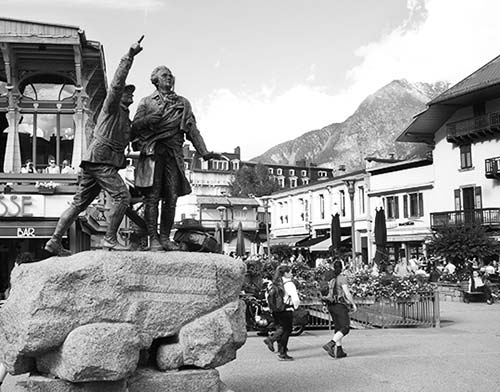
Raging underneath is the Arve River. Born near the Swiss border, it flows to Geneva where it joins the Rhône River’s run south to the Mediterranean. Sediment from glacial melt makes the water milky. (In winter, when little is melting, the river is smaller and much clearer.) In medieval times, the first bridge here was made of wood and used mostly by cows. Today’s stone bridge dates from 1880. Historically, whenever there’s a big melt and a heavy rain, the Arve would flood the town. But in the 1960s the river was channeled into a canal, and since then it’s been regularly dredged to help prevent flooding.
• Look across the street to the...
Casino: This was once one of Chamonix’s oldest hotels—built for Romantic Age travelers back when local guides carried aristocrats in sedan chairs up to see a glacier. The building has a northern Italian design—a reminder that this town (like Nice) was once part of the northern Italian kingdom of Savoy. Napoleon III came here in 1860, and from this building’s balcony he welcomed the citizens of Chamonix after they had voted to join France. The hotel later became a casino, part of Chamonix’s drive to be considered a real tourist resort.
• Walk to the left of the casino and into a grassy park, created in 2014, when its original huge trees were cut down (you’ll see the stumps and the massive timbers used for benches).
Park Couttet: The grassy expanse covers a hill, or moraine (rocky debris left by a receding glacier)—a reminder that a glacier once filled this valley. Informative panels tell about the geology. Walk to the back of the park to find La Maison des Artistes, an eclectic granite mansion that dates from the 1920s. Today it’s a popular jazz bar mixing great mountain views with booze and live music almost nightly in high season (closed Sun-Mon and in May & Oct).
• Turn left on the street behind the park and walk 200 yards to the train station.
Protestant Church: Across the street from the train station, hiding in a woodsy lot, is a small Protestant church—built in the 1860s for the many English visitors who traveled here on their Grand Tours. From here, with your back to the station, a walk straight down the main drag (Avenue Michel Croz) takes you back to the river, the statue of Paccard, and the center of Chamonix.
MOUNTAIN LIFTS, GONDOLAS, AND TRAINS
Map: Alpine Crossing from France to Italy
▲▲▲Lifts to Le Brévent and La Flégère
▲▲Hike #1 Plan de l’Aiguille to Montenvers-Mer de Glace (Le Grand Balcon Nord)
▲▲Hike #2 La Flégère to Planpraz (Le Grand Balcon Sud)
▲▲Hike #3 La Flégère to Lac Blanc
▲Hike #4 Petit Balcon Sud to Chalet de la Floria and Les Praz
Hike #5 Arve Riverbank Stroll and Paragliding Landing Field
Hike #6 Domaine de Balme—Hike to the Swiss Border
Espace Tairraz: Crystal Museum and Mountaineering Center (Musée des Cristaux and Espace Alpinisme)
The Aiguille du Midi (ay-gwee doo mee-dee) is the most spectacular mountain lift in Europe—and the most popular ride in the valley. If the weather’s clear, the price doesn’t matter. Take an early lift and have breakfast above 12,000 feet. Remember, it’s freezing cold up there and you’ll need sunglasses.
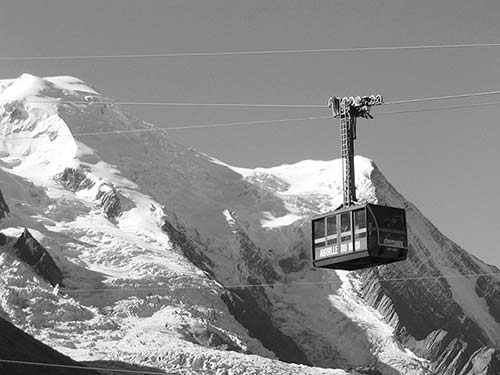
Cost: From Chamonix to Plan de l’Aiguille—round-trip-€33 (one-way-€18); Aiguille du Midi—round-trip-€62 (one-way-€50, not including parachute). Tickets for the Panoramic Mont Blanc télécabines from Aiguille du Midi to Pointe Helbronner (Italy) are sold at both base and summit lift stations with no difference in price (round-trip-€30). As conditions can change, I wouldn’t buy the Helbronner ticket until I’m at the top of Aiguille du Midi, where it’s easy to purchase. If dropping into Italy on the Skyway Monte Bianco, buy that ticket at Helbronner (€50, baggage allowed).
Discounts: The prices listed above are for ages 15-64; kids 4-14 and over 64 cost about 15 percent less (family rates for 2 adults and 2 children ages 14 and under are also available). While going all the way up and only halfway down (and hiking from Plan de l’Aiguille) costs the same as a round-trip ticket, those with a round-trip ticket who hike over to Montenvers can use it to ride the train back into Chamonix, which saves €28.
Hours: Lifts generally run daily July-Aug 6:30 or 7:00-18:00, late May-June and Sept 8:10-16:30, and Oct-mid-May 8:10-15:30, closed mid-May-late May and Nov-mid-Dec. Be warned: Hours can change with the weather, among other reasons. Always confirm plans locally. Gondolas run every 10 minutes during busy times; the last return from Aiguille du Midi is generally one hour after the last ascent. The last télécabine departure to Pointe Helbronner is about 14:30, and the last train down from Montenvers (for hikers) is between 17:00-18:00, depending on the season.
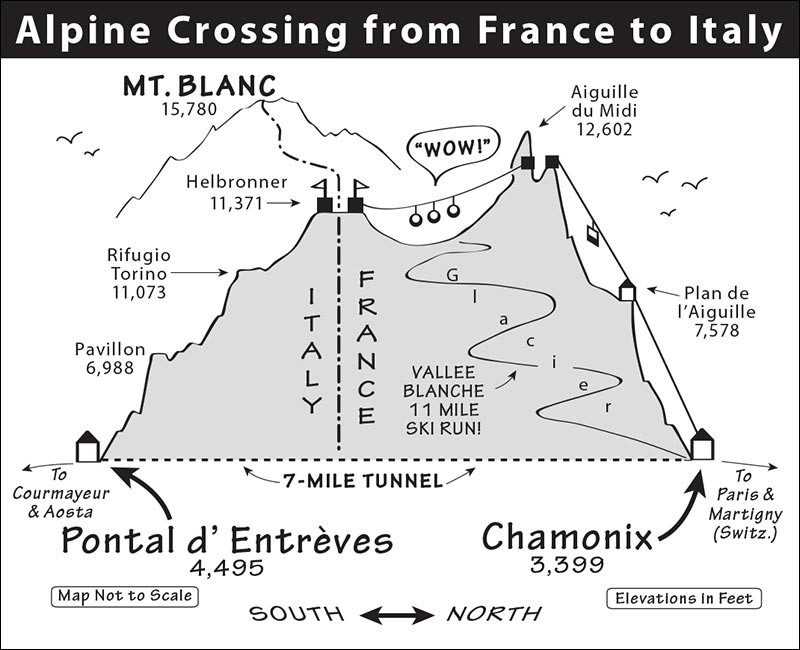
Crowd-Beating Strategies: To beat the hordes and clouds, ride the Aiguille du Midi lift (up and down) as early as you can (first lift departs at 6:30 or 7:00 in summer). To beat major delays in summer, leave no later than 8:00, no reservation needed. While you can reserve ahead for a later time, sights and trails will be busy the later you go. Crowds are worst on a sunny day after a string of bad days. If you arrive later in the day, you’ll likely be assigned a lift time and will have to come back.
You can reserve at the information booth next to the lift, online at www.montblancnaturalresort.com, or in person at this or other lifts (reservations are nonrefundable). Reservations are taken from one to seven days in advance (no same-day reservations, usually booked up one day out—try to reserve at least two days ahead). Pick tickets up at the lift station 20 minutes before departure (the information booth at the Aiguille du Midi lift tells you which window to use for priority access). Reservations are not possible for the télécabines to Helbronner.
Time to Allow: Chamonix to Aiguille du Midi—20 minutes one-way, 2 hours round-trip, 3 hours in peak season; Chamonix to Helbronner—about 45 minutes one-way, 3 hours round-trip. (In peak season, you can get hung up by crowds at Helbronner.) On busy days, minimize delays returning to Chamonix by making a reservation for your return lift time upon arrival at the top of Aiguille du Midi. (When crowded, attendants hand out return-time cards as you arrive—ask for advice when you get to the top.)
Pile into the téléphérique (gondola), try to grab a window spot, and soar to the tip of a rock needle 12,602 feet above sea level (you’ll be packed into the gondola like sardines; take off your daypack to allow more room). Chamonix shrinks as trees fly by, soon replaced by whizzing rocks, ice, and snow. Change gondolas at Plan de l’Aiguille to reach the top. Notice the receding glaciers on the right as you ascend. No matter how sunny it is, it’s cold and the air is thin. People are giddy with delight (those prone to altitude sickness or agoraphobia are less so). Fun things can happen at Aiguille du Midi if you’re not too winded to join the locals in the halfway-to-heaven tango.
Aiguille du Midi Station and the Summit: In the station, you’ll find several gift shops, cafeterias, view terraces, and many nooks and crannies to explore. The actual gondola station has shops and a view terrace, and an interesting exhibit about the history of the 1950s construction. The summit tower atop the peak looks like a spacecraft perched on an alp (look up as you walk out of the lift station).
A skybridge leads from the station past an information kiosk (which sells tickets for the Helbronner lift to Italy). Stop there to assess the crowds, the trip to Italy, and return-to-Chamonix options (remember, it may be quiet now, but later it can be horribly crowded with hours-long delays if you’re sloppy). Ask about reserving a time for your descent back into Chamonix.
The skybridge deposits you in the main building with an elevator to the summit. Before riding the elevator up, you can explore. An exhibit called “Vertical Space Extreme” thrills with amazing photos and videos of daredevil mountaineers. A tubular walkway called “The Tube” gets you away from the crowds to quieter views. Spot the climbers and ponder the value of an ice ax. Stairs near The Tube’s entry lead up to a heated room with an exhibit on Mont Blanc’s fragile environment.
Follow Vallée Blanche signs to a drippy “ice tunnel” where skiers and mountain climbers make their exit. The views are sensational if you can get close (only skiers/climbers allowed past a certain point); merely observing is exhilarating. Skiers make the 13-mile run to the Mer de Glace from here. Next to that is the gondola station for the Panoramic Mont Blanc lift to Helbronner (Italy).
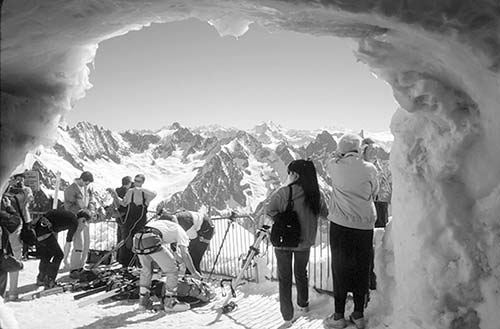
The highlight of your ascent is riding the elevator to the summit (signed Terrasse 3842)—12,602 feet above sea level (pose with the much-photographed altitude sign). From this platform, the Alps spread out before you. Use the orientation posters to identify key peaks: You can see the main Swiss and Italian summits rising above 13,000 feet. If it’s clear, you can see the bent little Matterhorn—the tall, shady pyramid listed in French on the observation table as “Cervin—4,505 meters” (14,775 feet). And looming on the other side is Mont Blanc, the Alps’ highest point, at 4,810 meters (15,780 feet).
Use the telescopes to spot mountaineers (roped up and following guides); more than 2,000 people scale Mont Blanc each year. A long but not technically challenging climb, the summit was first conquered in 1786, more than 170 years before this lift was built. Find the giant’s tooth, spot the télécabines to Italy, and identify lift stations of the Aiguilles Rouges mountain range across the valley, on the other side of Chamonix. That rusty tin-can needle above you serves as a communications tower. Check the temperature near the elevator.
At the summit, the “Step Into the Void” glass box offers a chance to stand in what feels like midair. (They’ll take your photo for a fee.) But it can be a long wait for a small payoff.
Taking the Gondola to Italy: For your private glacial dream world, embark on the little red Panoramic Mont Blanc télécabine and sail south to Pointe Helbronner, the mountaintop Italian border station (typically open late June-early Sept). This line stretches three miles over ice, snow, and rocks. In a gondola for four (if it’s not too crowded, you can usually get a private one for two if you ask), you’ll dangle silently for 40 minutes as you glide over glaciers and past a forest of peaks to Italy. Hang your head out the window. Enjoy the silence. Explore every corner of your view. From Helbronner, you can turn around and return to Aiguille du Midi, or descend into Italy on the Skyway Monte Bianco lift (described later, under “Day Trips near Chamonix”)—but for most there’s really no point unless you’re traveling on into Italy.
Helbronner station, at over 11,000 feet, has a whole different crowd (people coming up from Italy with no intention of going to Aiguille du Midi). There’s a cafeteria, a crystal hall, an elevator down to a passage that leads to the Torino Refugio climber’s refuge (with view terrace and restaurant), and, most importantly, spiraling stairs leading to a 360-degree viewing platform for killer views from the Matterhorn to Mont Blanc (called Monte Bianco here in Italy). Unfortunately, you need to keep an eye on the crowds and the slow line to assure your timely return to Aiguille du Midi.
Returning to Chamonix via Plan de l’Aiguille: To get from Aiguille du Midi to Chamonix, you’ll need to change gondolas at Plan de l’Aiguille. Take some time here on your way down. Gondolas depart every few minutes, and those boarding here never have to wait. At Plan de l’Aiguille you’ll find a scenic café with sandwiches, drinks, outdoor tables, paragliders jumping off cliffs (except in July-Aug), and rocky perches for private sunbathing. It’s a great place to just relax. But the best reason to get off here is to follow the wonderful trail to the Mer de Glace, then catch the train back into Chamonix (for details, see “Chamonix-Area Hikes—Hike #1,” later).
For a quick trip, find the Montenvers-Mer de Glace trail below the lift station and walk 15 minutes to the peaceful and cozy $ Refuge-Plan de l’Aiguille, where you can get reasonable meals (good omelets, pastas, salads, and mouthwatering tarts, made by welcoming manager Claude—no English, no problem) and drinks inside or out (open daily May-late Oct, mobile 06 65 64 27 53). It’s a manageable hike for most travelers (or a great overnight for a steal—see “Sleeping in Chamonix,” later).
Never hike all the way down to Chamonix from Plan de l’Aiguille or Montenvers-Mer de Glace; it’s a long, steep walk through thick forests with few views. Ride the gondola down, and notice as you’re finally dropping back into Chamonix the highway disappearing into the mountain—that’s the Mont Blanc Tunnel.
From Gare de Montenvers (the little station over the tracks from Chamonix’s main train station), the cute cogwheel Train du Montenvers toots you up to tiny Montenvers (mohn-tuh-vehr). Sit on the left-hand side as you go up for good views among pine trees over the valley. There you’ll see a dirty, rapidly receding glacier called the Mer de Glace (mayr duh glahs, “Sea of Ice”) and fantastic views up the white valley (Vallée Blanche) of splintered, snow-capped peaks. (As the glacier recedes, it is literally pulling away from the train station; in coming years you’ll see construction as the train tracks are extended to catch up with the ice.)
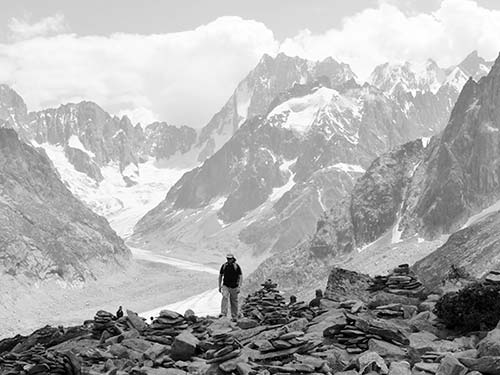
Cost and Hours: Round-trip-€33, one-way-€28, family rates available, prices include gondola and ice caves entry, daily 8:30-17:00, July-Aug 8:00-18:00, 2/hour, 20 minutes, confirm first/last trip times with TI or call 04 50 53 12 54.
Visiting the Glacier: Find the view deck across from the train station. France’s largest glacier, at eight miles long, is impressive from above and below. The swirling glacier extends under the dirt about a half-mile downhill to the left. Imagine that it recently reached as high as the vegetation below (see the dirt cliffs—called moraines—left behind in its retreat). In 1860, this glacier stretched all the way down to the valley floor (see the “Understanding the Alps” sidebar).
Use an orientation table as you look up to the peaks. Aiguille du Dru’s powerful spire, at about 11,700 feet, makes an irresistible target for climbers. It was first scaled in 1860 (long before the train you took here was built) and was recently free-climbed (no ropes, belays, etc.); the colored lines indicate different routes taken. The smooth snow field to the left of Dru’s spire (Les Grands Montets) is the top of Chamonix’s most challenging ski run, with a vertical drop of about 6,500 feet (down the opposite side). The path to the right (as you face the glacier) leads to a fine view café and a reconstruction of a crystal cave.
The glacier’s ice caves are beneath you (and are skippable for most). Take the free, small gondola down and prepare to walk about 500 steps each way. (Several years ago, it was 280 steps.) This glacier is beating a hasty retreat—as you walk down you’ll pass signs that bring this point home by showing the extent of the glacier over the years. The ice cave, a hypnotizing shade of blue-green, is actually a long tunnel dug about 75 yards into the glacier. Informative panels describe the digging of the cave.
The Terminal Neige/Refuge du Montenvers, a few minutes’ walk toward Chamonix from the viewing platform outside the station, offers a full-service restaurant, view tables (fair prices, limited selection), and a warm interior (you can even bunk here in style—see “Sleeping in Chamonix,” later). The hotel was built in 1880, when tourists arrived on foot or by mule.
The three-hour trail to Plan de l’Aiguille (see here for a description) begins across from the hotel. Follow signs for Le Signal/Plan de l’Aiguille past two stone buildings and track the trail as it rises (sometimes steeply, with no shade) just above the Mer de Glace valley. For terrific views, hike this trail just a short distance. The views get better fast, and the higher you climb, the better they get as the peaks of the Aiguilles Rouges come into sight behind you. Bring a picnic. Le Signal is a brilliant destination—but a long climb (figure one hour).
A Glaciorium lies 50 yards behind the hotel along the main walkway. It houses a small but worthwhile exhibit on glaciers of the world with dioramas, a film, interactive displays, and terrific images that explain the life of a glacier (all well described in English). As you leave you’re reminded that more than two-thirds of the world’s drinking water comes from glaciers (free, daily 9:30-18:00 in summer, 10:00-16:00 in winter).
Though Aiguille du Midi gives a more spectacular ride, the Le Brévent and La Flégère lifts offer worthwhile hiking and viewing options, with unobstructed panoramas across to the Mont Blanc range and fewer crowds. The Le Brévent (luh bray-vahn) gondola is in Chamonix; the La Flégère (lah flay-zhair) lift is in nearby Les Praz (lay prah). The lifts are connected by a scenic hike or by bus along the valley floor (bus is free with Chamonix Guest Card, see Hike #2 in the next section); both have sensational view cafés. Both lifts are closed from late April to mid-June and again by mid-September (reopening when ski season starts, usually in Dec).
This gondola, a steep 10-minute walk up the road above Chamonix’s TI, is a worthwhile trip just for the ride and view cafés alone (ideal with a Multipass). It takes two gondolas to reach Le Brévent’s top. The first gondola to Planpraz, with automated eight-person télécabines, runs every minute. Sit backward and watch Chamonix shrink away below (round-trip to Planpraz-€18, one-way-€14). Planpraz merits a little exploring—there are view restaurants and cafés and good hiking options. The free little funicular (Funi) takes you up to a view platform where you’ll find parasailers and an easier start if you want to hike between Planpraz and La Flégère (my Hike #2 in reverse).
The second gondola to Le Brévent station leaves from Planpraz and runs every 5-15 minutes. At the top, you get 360-degree views, more hikes, an exhibit on how the region has evolved over 60,000 years, and a smashing view café. It’s a fine stop, but for most, Planpraz is plenty high (round-trip from Chamonix to Le Brévent-€33, one-way-€24; daily 8:45-17:00, July-Aug 8:15-18:00, last return from Planpraz one hour after last ascent, closed late April-mid-June and mid-Sept, tel. 04 50 53 13 18).
This lift runs from the neighboring village of Les Praz to La Flégère station every 15 minutes; to go higher, take the chairlift to L’Index (La Flégère round-trip-€18, one-way-€15 L’Index round-trip-€30, one-way-€25; daily 8:15-16:45, summer 8:00-17:30, last return from La Flégère 15 minutes after last ascent, closed late April-mid-June and mid-Sept, tel. 04 50 53 18 58). Hikes to Planpraz and Lac Blanc leave from the top of this station (see Hikes #2 and #3 in the next section). Les Praz is easy to reach from Chamonix by local bus (10 minutes—it’s the first stop after Chamonix).
(See “Chamonix—Area Hikes” map.)
The Maison de la Montagne service center is a good first stop for serious hikers (located across from the TI, first-floor WC). On the second floor, the Office de Haute-Montagne (High Mountain Office) can help you plan your hikes and tell you about trail and snow conditions (daily 9:00-12:00 & 15:00-18:00, tel. 04 50 53 22 08, www.chamoniarde.com). The staff speaks enough English and has vital weather reports and maps, as well as some English hiking guidebooks to consult. Ask to look at the trail guidebook (sold in many stores and at the TI, includes the helpful Carte des Sentiers, the region’s hiking map).
At Compagnie des Guides de Chamonix on the ground floor, you can hire a mountaineering or climbing guide (about €220/half-day, €350/day, less per person for groups) to help you scale Mont Blanc, or hike to the Matterhorn and Zermatt (open daily 9:00-12:00 & 14:30-19:00, closed Sun-Mon off-season, tel. 04 50 53 00 88, www.chamonix-guides.com). Up a few steps is an adventure-sports office.
In this section, I describe three fairly strenuous hikes and three easier walks (see the “Chamonix-Area Hikes” map). Start early, when the weather’s generally best. This is most important in summer as trails become more crowded as the day goes on. If hiking late in the day, confirm lift closing hours to avoid a long, steep hike down.
For your hike, bring sunglasses, sunscreen, rain gear, water, snacks, and maybe light gloves. Pack warm layers (mountain weather can change in a moment) and wear good shoes (trails are rocky and uneven). Take your time, watch your footing, don’t take shortcuts, and say “Bonjour!” to your fellow hikers. Note that there’s no shade on Hikes #1, #2, and #3.
This three-hour hike (including breaks) is the most efficient way to incorporate a high-country adventure into your ride down from the valley’s greatest lift, and check out a world-class glacier to boot. The spectacular, well-used trail rises but mostly falls (dropping 1,500 feet from Plan de l’Aiguille to Montenvers and the Mer de Glace) and is moderately difficult, provided the snow has melted (generally snow-covered until June; get trail details and conditions at the Office de Haute-Montagne, listed earlier). A few stretches are steep and strenuous, with uneven footing and slippery rocks. Wear good shoes (hard soles are better) and watch your footing. Note the last train time from Montenvers-Mer de Glace back to Chamonix, or you’ll be hiking another hour and a half straight down.
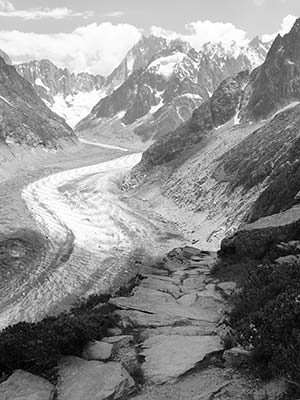
To experience this marvelous hike at its peaceful best, go early. In mid-July, I started the trail at 9:15 (after visiting the Aiguille du Midi) and didn’t meet another hiker for over an hour. If you start very early, shade covers the trail for long stretches.
From the Aiguille du Midi lift, get off halfway down at Plan de l’Aiguille, sortie to the café/bar, then find signs leading down to Montenvers-Mer de Glace. Follow the main trail that is parallel to the gondola cables (avoid spur trails to the right). You’ll drop steadily for 15 minutes down to a wonderful refuge (the recommended Refuge-Plan de l’Aiguille, good prices for meals and drinks), then go right, hiking the spectacularly scenic, undulating, and (for short periods) strenuous trail to Montenvers (overlooking the Mer de Glace glacier). Plan on lots of boulder-stepping and occasional stream crossings. Stop frequently to turn around and savor the views.
After hiking little more than an hour at a moderate yet steady pace, the trail splits. Follow signs uphill to Le Signal (more scenic and easier), rather than to the left toward Montenvers (it looks easier, but becomes very difficult—and you miss the best views). At this point, you’ll grind it out uphill for about 20 minutes, level off, and then climb more gradually to the trail’s best views at Le Signal. Savor the 360-degree panorama of splintered peaks that you worked so hard to reach, and make your own stone monument. From here, it’s a long and sometimes steep, but memorable, half-hour drop to Montenvers and the Mer de Glace. In Montenvers, take the train back to Chamonix. Don’t walk the rest of the trail down from Montenvers (long, steep, and disappointing views).
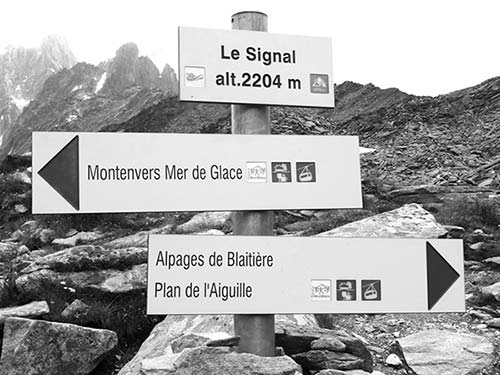
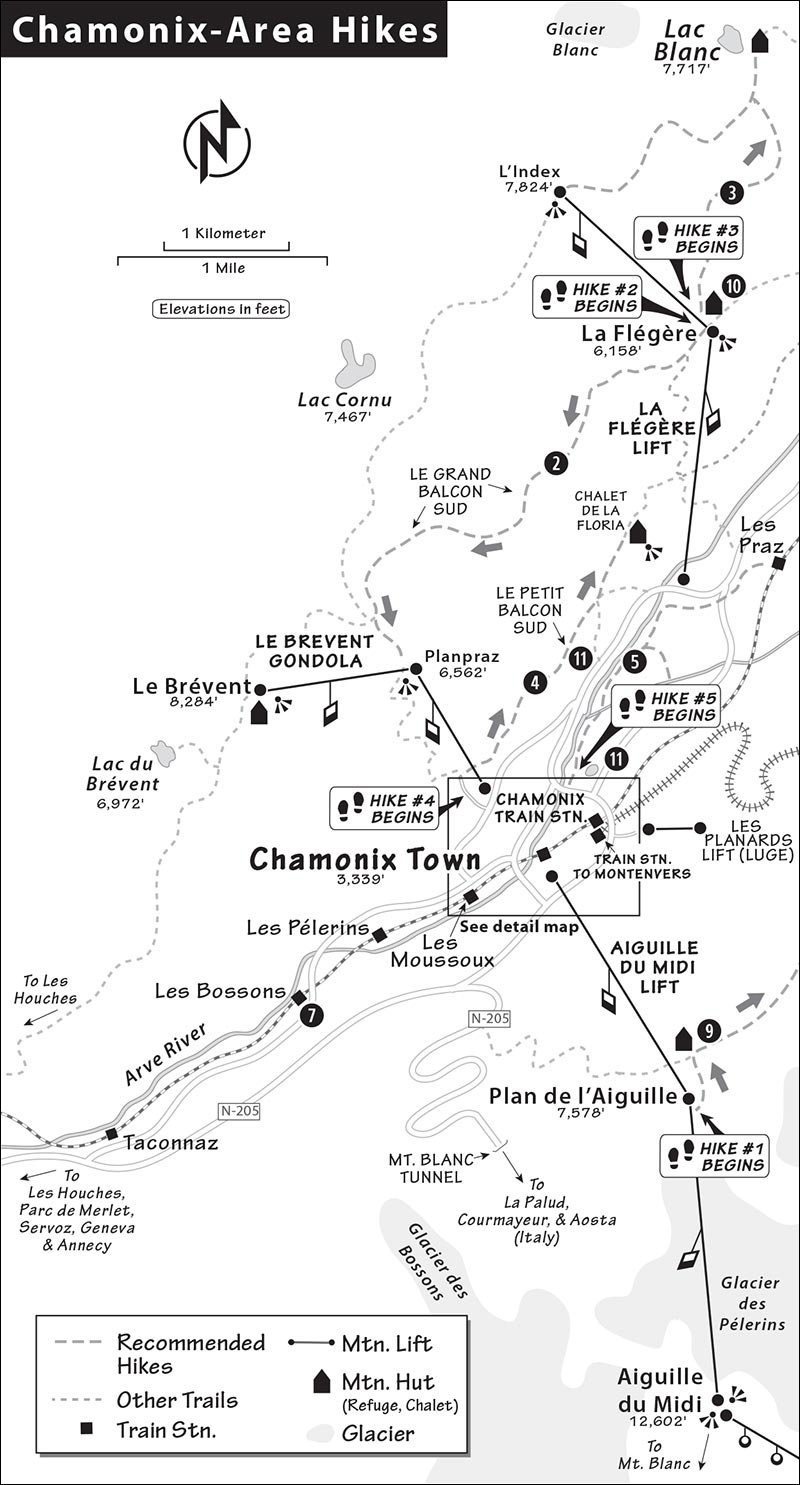
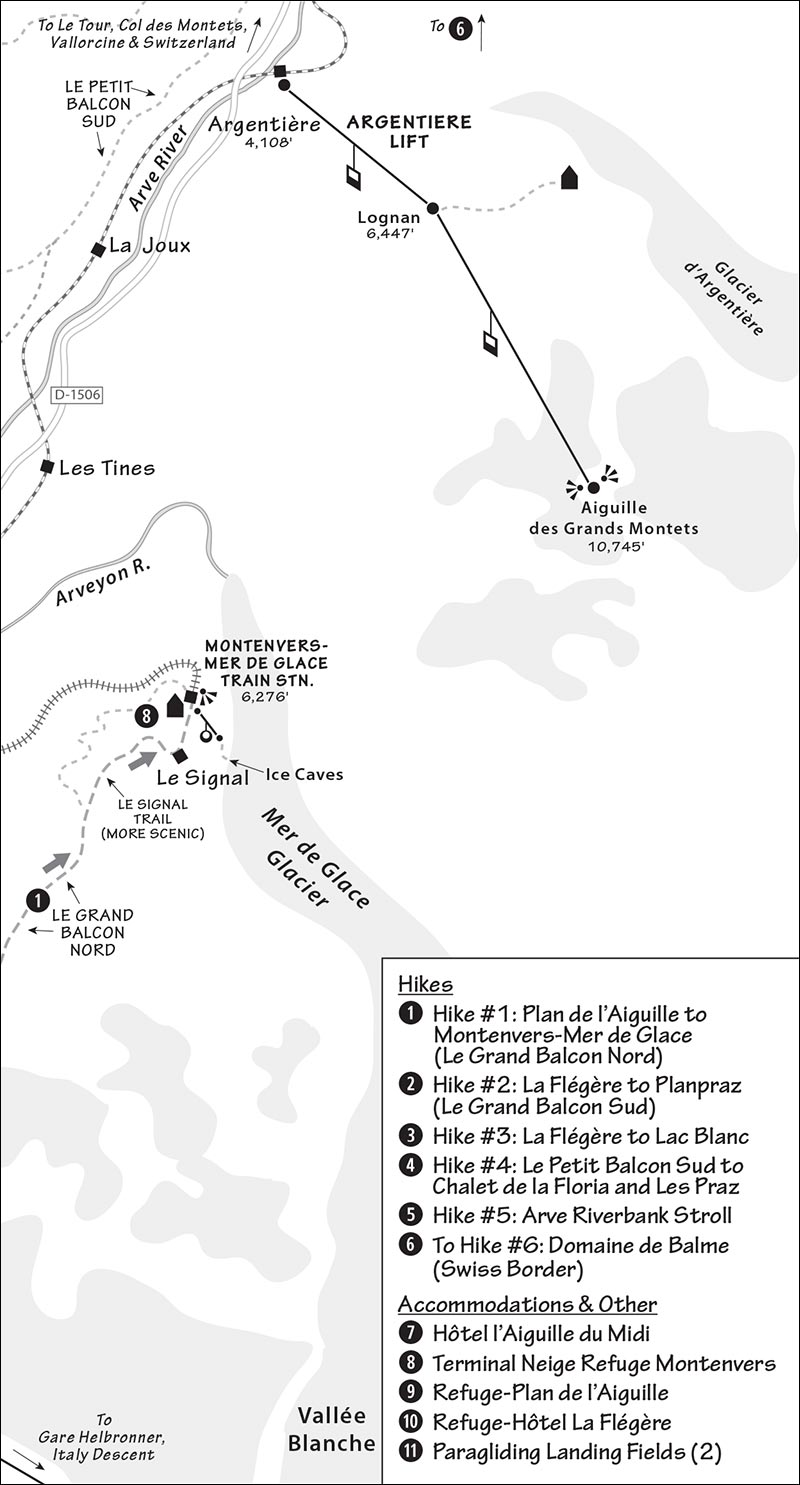
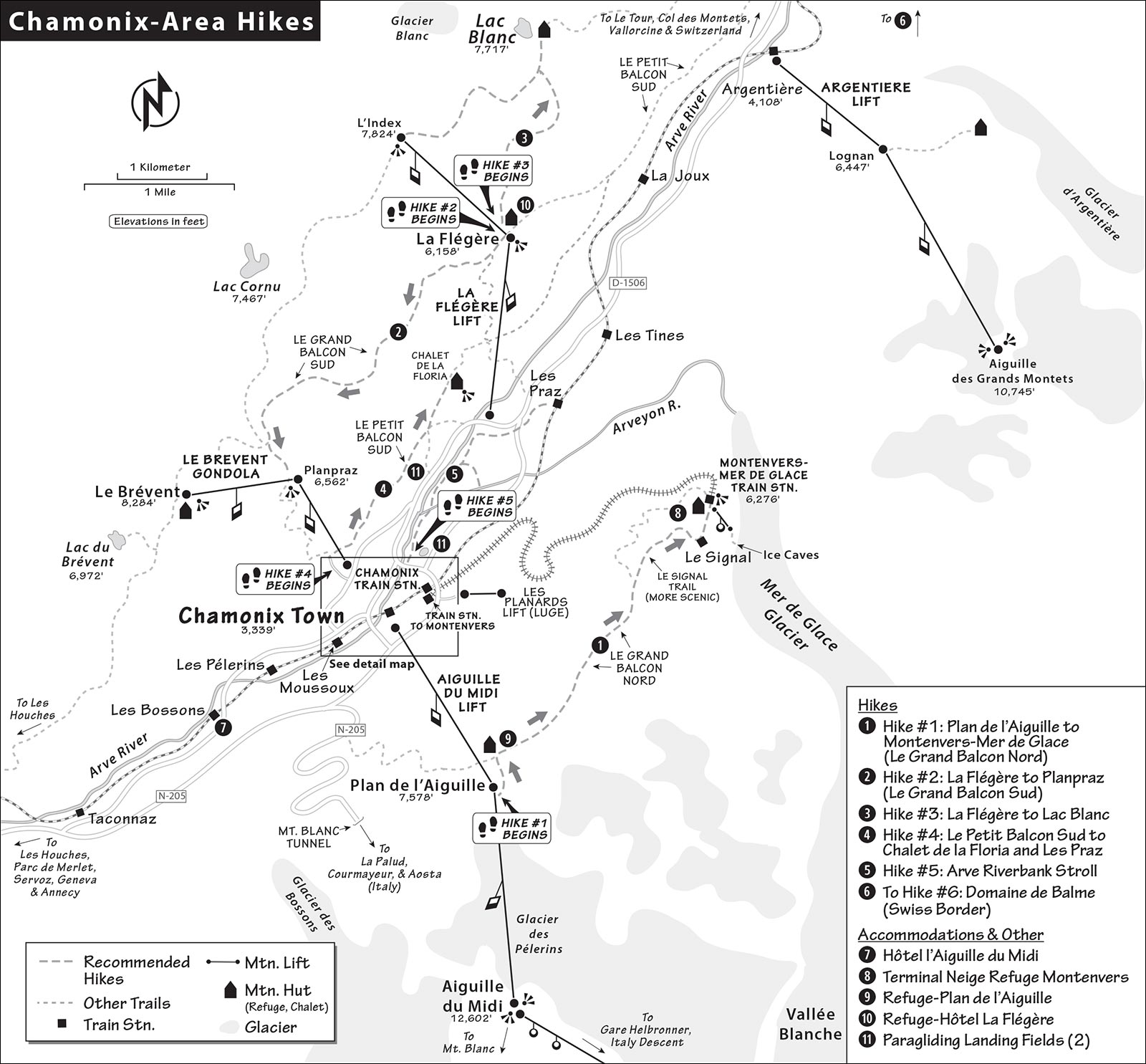
This lovely hike traverses for 2.5 hours above Chamonix Valley, with staggering views of Mont Blanc, countless other peaks, glaciers, wildflowers, and a fraction of the crowds that the Aiguille du Midi lift draws. While you’ll start at 1,900 meters (6,230 feet) and end at 2,000 meters (6,560 feet), there’s a lot more than just 100 meters (330 feet) of climbing between the La Flégère and Planpraz lift stations. While it’s possible to hike the trail in either direction, it’s better to start in La Flégère, which is the direction I describe below.
This hike is moderately strenuous (but still requires stamina and appropriate shoes). The trail is a mix of dirt paths, ankle-twisting rocky sections, and short stretches of service roads. You’ll pass by winter lifts and walk through meadows and along small sections of forest. Keep your eyes out for signs to Planpraz; red-and-white markers also help identify the trail.
The round-trip rate saves about €3 over two one-way tickets and lets you go up the La Flégère lift and down at Planpraz. To reach La Flégère, take bus #1 or #2 from Chamonix (free with Chamonix Guest Card), or walk 40 minutes along the Arve River to Les Praz (see Hike #5, described later). Take the lift up to La Flégère, then walk out the back to near the snack stand to get your bearings. Before setting out, stop by the lift ticket booth to confirm your hike plan, the trail, and the time of the last descent from Planpraz (if you’re there by that time, you won’t be stuck). Enjoy views of the receding Mer de Glace glacier and the cliff-hanging Hôtel du Montenvers on the opposite side of Chamonix’s valley.
To start the trail, walk down to the refuge just below the lift station and turn right, crossing under the gondola cables to Planpraz. (You don’t want Les Praz-Chamonix—that’s straight down.)
Signage is inconsistent, so expect to do some route-finding along the way. There are two points where you could miss the trail, each when you reach a small road. At the first road, cross and follow the Croisement du Sentier à 100 m sign, and later a sign to Planpraz. At a second road, above a ski lift, cross the road and take the rocky trail steeply uphill, following the Le Brévent par Planpraz sign. At the end, there’s a steep climb to the (Planpraz) gondola station (great view cafés, parasailers, and a good history exhibit). Descend to Chamonix from here or take the gondola up to Le Brévent for more views.
This is the most demanding trail of those I list; it climbs steeply and steadily over a rough, boulder-strewn path for 2 hours to snowy Lac Blanc (pronounced “lock blah”). Some footing is tricky, and good shoes or boots are a must. I like this trail, as it gets you away from the valley edge and opens views to peaks you don’t see from other hikes.
The destination is a snow-white lake framed by peaks and the nifty Refuge-Hôtel du Lac Blanc, which offers good lunches (and dinners, if you stay the night, summers only). The views on the return trip are breathtaking. Check for snow conditions on the trail (often a problem until July) and go early (particularly in summer), as there is no shade and this trail is popular.
Follow the directions for Hike #2 to La Flégère station, then walk out the station’s rear door past the snack stand to get oriented. Track the trail as it drops way down to that winter chairlift station, then hooks hard left back up a steep hill. You can avoid this considerable down-and-up (and save 30 minutes) by taking the L’Index chairlift behind you (about €10 one-way, €11 round-trip, €30 from the base). Confirm that the trail from L’Index is free of snow, as this shortcut can be dicey, especially for kids. However you start, the trail is well-signed to Lac Blanc, and its surface improves as you climb.
This trail runs above the valley on the Brévent side from the village of Les Houches to Argentière, passing Chamonix about halfway, and is handy when snow or poor weather make other hikes problematic. No lifts are required—just firm thighs for the climb up and down. Access paths link the trail to villages below. Once you’re up, the trail rises and falls with some steep segments and uneven footing. The highlight of the trail is flower-covered Chalet de la Floria snack bar (allow one hour each way from Chamonix).
Reach the trail from Chamonix by starting at the Le Brévent gondola station (find signs to Le Petit Balcon Sud). Begin by walking along an asphalt road to the left of the lift leading uphill (on Chemin de la Pierre à Ruskin), which turns into a dirt road marked as the Petit Balcon Sud trail. After about 20 minutes on the dirt road, you’ll see a Petit Balcon Sud sign pointing left and up a smaller trail. Bypass this turnoff (which doubles back above Chamonix with great views) and continue along the dirt road.
After about 30 more minutes, follow la Floria signs on a 20-minute round-trip detour to Chalet de la Floria, which has drinks, snacks, flowers, and magnificent views (daily mid-June-mid-Oct). From here, the trail continues above Les Praz to the north; junction trails lead back down to Chamonix or to Les Praz village. Following the junction trail to Les Praz eventually lands you on the main road; turn left to explore the village and to connect with the river trail back to Chamonix (the trail is immediately to the right after the bridge), or turn right on the road to reach the bus stop back to Chamonix (it takes bus #2 about 15 minutes to reach Les Praz from the time point posted in Le Tour; bus #1 starts a minute away at the Les Praz/La Flégère lift; and bus #21—summer only—starts about 17 minutes away at Col des Montets).
For a level, forested-valley stroll, bike ride, or jog, follow the Arve River toward Les Praz. At Chamonix’s Hôtel Alpina, follow the path upstream past Chamonix’s middle school, red-clay tennis courts, and find the green arrow to Les Praz. You’ll cross a few bridges to the left, turn right along the rushing Arve River, and then follow Promenade des Econtres. Several trails loop through these woods; if you continue walking straight, you’ll reach Les Praz in about an hour—an appealing destination with a number of cafés and a pleasing village green.
If you keep right after the tennis courts (passing piles of river sediment dredged to deter flooding), you’ll come to a grassy landing field, signed Parapente, where paragliders hope to touch down. Walk to the top of the little grassy hill for fine Mont Blanc views and a great picnic spot.
For a memorable and easy hike, consider this: Ride the local bus to Le Tour (free with Chamonix Guest Card, 2/hour, 25 minutes). From there, catch the gondola to Charamillon and from Charamillon a chairlift (€30 round-trip, lifts run about 9:00-17:00) takes you to Les Autannes at over 7,200 feet. At the top, it’s an easy 20-minute walk in an alpine wonderland through meadows and past cows to the Swiss border at Col de Balme. There you’ll find a stone marked with France on one side and Switzerland on the other and, nearby, a mountain hut. When you’re ready to head back, backtrack the way you came and find the trail near the top of the chairlift. It’s a one-hour hike down to the top of the gondola for the ride back down to Le Tour.
Here’s something for fun-seekers: Ride a plastic sled on rails up the hill, and then scream down a twisty, banked slalom course. Young or old, hare or tortoise, any fit person can manage a luge. Freinez signs tell you when to brake. The luge course is set in a grassy park with kids’ play areas.
Cost and Hours: One ride-€7, six rides-€40, ask about double sleds, kids under 8 must ride with adult, entry includes all activities in Parc de Loisirs des Planards—see the “Kids’ Activities” sidebar, earlier; generally July-Aug daily 10:00-18:30, mid-April-June and Sept-Oct Sat-Sun and select weekdays 13:30-18:00, check website for hours; 15-minute walk from town center, over the tracks from train station and past Montenvers train station; tel. 04 50 53 08 97, www.chamonixparc.com.
When it’s sunny and clear, the skies above Chamonix sparkle with colorful parachute-like sails that circle the valley like birds of prey. For €110-120 plus the cost of the lift up to Planpraz (Le Brévent ski area) or Plan de l’Aiguille, you can launch yourself off a mountain in a tandem paraglider with a trained, experienced pilot and fly like a bird for about 20 minutes (true thrill-seekers can launch from Aiguille du Midi, €280, 40-minute ride). Most pilots will meet you at the lift station in Chamonix (usually from Le Brévent side, as it has the most reliable conditions, though you can ask them to fly you from Plan de l’Aiguille if you’ll be there anyway and are pressed for time—not possible July-Aug). Sean Potts is English (no language barrier), has been paragliding in Chamonix for 25 years, and is easy to work with (www.fly-chamonix.com, info@fly-chamonix.com). You can also try Summits Parapente (smart to reserve a day ahead, open year-round, tel. 04 50 53 50 14, mobile 06 84 01 26 00, www.summits.fr).
For a sneak preview, walk to one of the two main landing areas and watch paragliders perfect their landings (see “Chamonix-Area Hikes—Hike #5,” earlier).
If the weather disagrees with your plans, stay cool and check out the following options.
Situated in one of Chamonix’s oldest “palaces,” this place has good exhibits about Chamonix’s evolution from a farming area to one focused on skiing. The museum shows off Chamonix’s mountaineering, skiing, and mineralogical history (explanations in French only) and has exhibits on the first Winter Olympics, held right here.
Cost and Hours: €6, July-Aug daily 10:00-13:00 & 14:00-18:00, otherwise 14:00-18:00 and closed on Tue, 89 Avenue Michel Croz, tel. 04 50 53 25 93.
The Espace Tairraz has two parts: a fascinating collection of crystals (with samples from all over the world in every color, shape, and size; get the English leaflet for some explanation), and a fascinating mountaineering museum covering the sport from 1786 to the present day. You’ll learn of the great climbers through the ages, trace the evolution of mountain huts, and experience some of the best local ascents on video footage. The interactive climbing simulator is a hit with children and adults alike. Be aware that the center will close in June 2019 for renovations,
Cost and Hours: €6, daily 14:00-18:00, from 10:00 July-Aug, 615 Allée Recteur Payot, tel. 04 50 55 53 93.
One of Chamonix’s most celebrated nature photographers displays his mesmerizing photographs of the scenery high above you. Don’t miss the photos upstairs. These are so good you may not miss seeing the real thing.
Cost and Hours: Free, daily 10:00-12:30 & 15:00-19:30, no midday closure July-Aug, a block from the train station at 19 Rue Whymper, tel. 04 50 91 40 20, www.mario-colonel.com.
Plenty of tempting alpine and cultural thrills await just an hour or two away in Switzerland. A scenic road and rail route sneaks you from Chamonix to the Swiss town of Martigny. Train travelers cross without formalities, but drivers are charged a one-time fee of 40 Swiss francs (roughly €36) for a permit, known as a vignette, to use Swiss autobahns.
The remote Valle d’Aosta and its historic capital city of Aosta offer a serious change of culture. The side trip is worthwhile if you’d like to taste Italy (spaghetti, gelato, and cappuccino), enjoy the town’s great evening ambience, or view the ancient ruins in Aosta (often called the “Rome of the North”).
Getting There: Take the spectacular lift (Aiguille du Midi–Helbronner—described earlier) to Italy. From Helbronner, ride the Skyway Monte Bianco lift, which stops at Pavillon du Mont Fréty on its way down to Pontal d’Entrèves (www.montebianco.com). It’s an amazing ride—the gondola rotates 360 degrees as you sail along. From Pontal d’Entrèves, you can take the bus to Aosta (hourly, change in Courmayeur). Aosta’s train station has connections to anywhere in Italy (about every 2 hours, usually on slow trains via Turin).
For a more down-to-earth experience, you can take the bus from Chamonix to Aosta via the Mont Blanc Tunnel. Flixbus offers good deals and comfort (www.flixbus.com); or try local SAT buses (about €20 one-way, €38 round-trip, reservation required in summer; 5/day July-mid-Sept; 2-3/day mid-Sept-June Mon-Sat, none Sun; 2 hours). Get schedules at 13 Avenue Michel Croz, near the Alpine Museum (tel. 04 50 53 00 95, www.sat-montblanc.com), or at Chamonix’s bus station, 234 Avenue de Courmayeur. Drivers can travel straight through the Mont Blanc toll tunnel (one-way-€46, round-trip-€58 with return valid for 1 week, www.tunnelmb.com).
Reasonable hotels and dorm-like chalets abound in Chamonix, with easy parking and quick access from the train station. The TI can help you find budget accommodations anytime—either in person or by email (reservation@chamonix.com). Outside of winter, mid-July to August is most difficult, when some hotels have five-day minimum-stay requirements. Very few hotels offer air-conditioning, but most have elevators. Prices tumble off-season (outside July-Aug and Dec-Jan). Many hotels and restaurants are closed in May, June, and November, but you’ll still find a room and a meal. If you want a view of Mont Blanc, ask for côté Mont Blanc (coat-ay mohn blah). Travelers who visit June through September should contemplate a night high above in a refuge-hotel.
Ask at your hotel about the free Chamonix Guest Card, which provides complimentary use of most buses and trains during your stay (described on here).
$$$ Hôtel Hermitage,**** a 10-minute walk from the town center, is a gorgeous chalet hotel with the coziest lounges in Chamonix and a lovely garden with views. It has a small bar, a small sauna, and 28 alpine-elegant rooms, all with balconies and reasonable prices considering the quality (big family rooms and suites, easy parking, closed mid-Sept-mid-Dec and mid-April-mid-June, near train station at 63 Chemin du Cé, tel. 04 50 53 13 87, www.hermitage-paccard.com, info@hermitage-paccard.com).
$$$ Grand Hôtel des Alpes**** rents top-comfort rooms in a grand old building with wads of character in Chamonix’s traffic-free area. Rooms are big, cushy, and traditional, public spaces are wood-paneled cozy, and there’s a garden terrace (private garage, 75 Rue du Docteur Paccard, tel. 04 50 55 37 80, www.grandhoteldesalpes.com, info@grandhoteldesalpes.com).
$$$ Le Génépy offers 10 apartments facing a central and peaceful courtyard just off Rue Joseph Vallot. Rooms are bright, modern, and well-designed with fully equipped kitchens. Apartments on the second and third floors come with views of Mont Blanc (arrange ahead for arrival after 19:00, 16 Impasse du Génépy, tel. 04 50 53 05 62, www.legenepy-chamonix.com, contact@legenepy-chamonix.com).
$$ Hôtel l’Oustalet*** is a chalet hotel warmly run by two sisters (Véronique and Agnès) who understand the importance of good service. The place is family-friendly, with lots of grass, a big pool, and six family suites. All rooms are wood-paneled, with views and balconies (terrific breakfast-€15, try the teurgoule rice pudding; sauna and Turkish bath, free and secure parking, near Aiguille du Midi lift at 330 Rue du Lyret, tel. 04 50 55 54 99, www.hotel-oustalet.com, infos@hotel-oustalet.com).
$$ Hôtel Gourmets et Italy*** is a 36-room place with comfy public spaces, a cool riverfront terrace, balcony views from many of its appealing rooms, and a small pool (some rooms with Mont Blanc view, family rooms, closed late April-early June and mid-Oct-mid-Dec, 2 blocks from casino on Mont Blanc side of river, 96 Rue du Lyret, tel. 04 50 53 01 38, www.hotelgourmets-chamonix.com, info@hotelgourmets-chamonix.com).
$$ Hôtel le Faucigny*** is peaceful with a Scandinavian feel and a welcoming vibe. This full-service hotel includes free loaner bikes, sauna and hot tub, and afternoon tea and treats in the linger-longer lounge. The front terrace provides a tranquil retreat with mountain views, and its 27 rooms are tight but comfortable and quite modern (great breakfast, no elevator, 118 Place de l’Eglise, tel. 04 50 53 01 17, www.hotelfaucigny-chamonix.com, reservation@hotelfaucigny-chamonix.com). The hotel also manages a beautiful chalet next door, $$$ Le Whymper, with 10 top-comfort rooms designed for small groups plus a pleasant central living room (rooms rented to individuals when not taken by groups, inquire at hotel, no elevator).
$$ Hôtel de l’Arve*** offers midrange comfort with a contemporary alpine feel in its 37 rooms, some right on the Arve River looking up at Mont Blanc, most with balconies. This hotel comes with a fireplace lounge, a pool table, a pleasant garden, a sauna, a climbing wall, and easy, free parking. Check their website for deals (family rooms, several “apartments” ideal for families, 60 Impasse des Anémones, tel. 04 50 53 02 31, www.hotelarve-chamonix.com, reservation@hotelarve-chamonix.com).
$ Hôtel le Chamonix,** across from the TI and above a café, has simple alpine charm, with 16 paneled rooms at fair rates and no elevator. The rooms facing Mont Blanc have great views, are larger and brighter, and have little balconies...but also attract noise from le café below, which closes late on weekends (breakfast extra, 11 Rue de l’Hôtel de Ville, tel. 04 50 53 11 07, www.hotel-le-chamonix.com, hotel-le-chamonix@wanadoo.fr).
¢ Chalet Ski Station, filling a 300-year-old building, is a spartan but clean hostel that bustles with youthful energy. Gentle Veronique rents 44 beds to a young and sporty crowd who don’t mind the steep 10-minute climb above town to the base of the Le Brévent gondola (self-serve kitchen, 6 Route des Moussoux, tel. 04 50 53 20 25, www.hostel-skistation-chamonix.com, chaletskistation@wanadoo.fr).
¢ Le Vagabond Gîtes offers the best cheap digs in Chamonix in a fun chalet just south of the town center. Dorm rooms have bunks, with basic showers and toilets down the hall; all rooms have sinks. The top floor has one family room. The staff is a mix of British expats, and the feel is relaxed, with a bar and outside terrace (private rooms available, includes breakfast, reception closed 10:00-16:30, 305 Avenue Ravanel le Rouge, tel. 04 50 53 15 43, www.gitevagabond.com, info@vaga.eu).
If Chamonix overwhelms you, spend the night in one of the valley’s often-overlooked, lower-profile villages.
$$$ Hôtel l’Aiguille du Midi,*** a mountain retreat, lies near the train station in the village of Les Bossons, about two miles from Chamonix toward Annecy. It’s run by the English-speaking Farini family in a parklike setting with point-blank views of Mont Blanc and the Bossons Glacier. This family-friendly place has a swimming pool, a clay tennis court, table tennis, a massage room, and a laundry room to boot. Most of the alpine-comfortable rooms come with modern bathrooms, many have decks with views, and several are good for families. A few budget rooms (chambres économique) lack views but have access to all the amenities. The classy restaurant offers à la carte and menu options, with menus from €35 (RS%, family rooms, elevator, easy by train, get off at Les Bossons, tel. 04 50 53 00 65, www.hotel-aiguilledumidi.com, info@hotel-aiguilledumidi.com).
Chamonix has the answer for hikers who want to sleep high above, but aren’t into packing it in: refuge-hotels (generally open mid-June to mid- or late Sept, depending on snow levels). Refuge-hotels usually have some private rooms (but mostly dorm rooms), hot showers down the hall, and restaurants. Most require you to take dinner and breakfast there (a great value, and you don’t have many alternatives anyway). Reserve in advance (a few days is generally enough), then pack a small bag for a memorable night among new international friends. The Office de Haute-Montagne in Chamonix can explain your options (see here).
$$ Terminal Neige Refuge Montenvers, Chamonix’s oldest and classiest refuge, was built in 1880 as a simple climbing base for mountain guides before the train went there. Today’s 16 wood-cozy rooms have been restored to their original look, and there’s a 10-bed dorm room with comfy sleeping nooks. The dining room has alpine character, and the terrace tables have the views (at the Montenvers train stop, May-Sept & Nov-Dec, half-board required but reasonable, tel. 04 57 74 74 74, http://refuge.terminal-neige.com, contact@tn-refuge.com). For directions, see “Hike #1” on here.
¢ Refuge-Plan de l’Aiguille is a wonderful experience near Chamonix. It’s a small, welcoming, fairly easy-to-reach refuge a 15-minute walk below the Plan de l’Aiguille lift, right on the trail between the Aiguille du Midi and Montenvers-Mer de Glace. It has a warm interior and a $ café/restaurant with a killer view. The friendly cook and guardian Claude is a retired pastry chef, so the meals are good and the desserts heavenly (some private rooms, half-board required but reasonable, open May-late Oct, mobile 06 65 64 27 53, http://refuge-plan-aiguille.com, claudius74@hotmail.com).
¢ Refuge-Hôtel La Flégère hangs on the edge right at the La Flégère lift station. It’s simple and big, but ideally located for hiking to Lac Blanc or Planpraz (open mid-June-mid-Sept only, fireplace, cool bar-café, mobile 06 03 58 28 14, www.autourdumontblanc.com, bellay.catherine@wanadoo.fr). For directions, see “Hike #2” on here.
You have plenty of dining options in Chamonix: cozy, traditional savoyard restaurants serving classic local dishes; rustic sports bars with typical brasserie fare; big, kitschy family-friendly eateries that smell like cheese from all the fondue and raclette they serve; and trendy, modern foodie haunts. You can sit on a terrace overlooking the rushing river or on the main square watching the steady stream of outdoor enthusiasts. Restaurants seek to satisfy ravenous hikers with the hearty and filling regional cuisine. The most popular beer is the local Mont Blanc amber (Rousse de Mt. Blanc), and water is free for the asking. Menus are often similar—it’s the atmosphere that varies. Most restaurants open by 18:00 or serve nonstop, making early dinners easy.
$$$ Atmosphère Restaurant is serious and pricey, but a fair value. Dressy and jazzy with a white-tablecloth ambience, they serve a mix of savoyard and French cuisine from an elegant menu. In high season two dinner seatings are offered on their long, skinny riverfront terrace: 19:15 and 21:15. To get a table literally over the torrent, make a reservation; skip this place if you can’t dine riverside (daily, 123 Place Balmat, tel. 04 50 55 97 97, www.restaurant-atmosphere.com).
$$ Restaurant Bizes (Little Kisses) is a cool little place popular with foodies, offering fine dining (inside and out) in a small modern spot right on the rushing river. While they are enthusiastic about vegetarian and gluten-free dishes, they also do lots of grilling in their charcoal oven. With modern international dishes (ranging from smoked prawns to chicken curry), this place offers a fun break from heavy traditional fare (daily, 64 Rue du Lyret, tel. 09 51 92 25 03).
$$$ La Calèche is a kitschy, touristy, and traditional place with a fun, family-friendly energy, reasonable prices, and wild boars and stuffed birds on the walls. If you want to eat fondue or raclette (served in the traditional way) and feel like you’re in an alpine museum (find the luge from the Chamonix 1924 Olympic Games), this is it. It’s often still hopping when other places have closed for the night (daily, centrally located just off Place Balmat at 18 Rue du Docteur Paccard, tel. 04 50 55 94 68).
$ Elevation 1904 is a down-and-dirty climbers’ haunt across from the train station, serving cheap and tasty sandwiches, burgers, pasta, and salads (daily until about 22:00, 263 Avenue Michel Croz, tel. 04 50 53 00 52).
$$ Bistrot des Sports is where you’ll feel like you’re hanging out with the locals. The lively bar has a fun energy, and the big back room is a casual, family-friendly restaurant with a French brasserie menu featuring big salads, regional specialties and fondue, pastas, and vegetarian dishes. Local craft beers, an enticing wine list, and plenty of wines by the glass add to the conviviality of the place. While you can sit outside, I’d come here to eat in (daily, kitchen closes at 21:30, 176 Rue Joseph Vallot, tel. 04 50 53 00 46).
$ Le Chamonix Bar-Café is a classic café with a cheap and accessible menu. Sitting below Chamonix’s pretty little church (facing the TI) with terrific mountain views, they serve simple, tasty light meals. Their tartine (hot open-faced sandwiches) and café gourmand (coffee with a selection of desserts) are a hit (daily until 21:00, cash only, Place de l’Eglise, tel. 04 50 53 32 14).
$ La Maison du Burger is a simple takeout joint with a few plastic tables on the pedestrian street right downtown. They serve a fun array of burgers, toasted sandwiches, and crêpes—both sweet and savory (daily until 23:00, across from the recommended La Calèche restaurant).
Dining Well with a View: While many eateries offer great views, most serve mediocre food at inflated prices. Dining at a café on Place Balmat (by the statues), you’ll hear the rush of the Arve River and have great views of mountains and people. But you can do better, so consider these places:
$$ La Tablée is my go-to place for a fine meal at good prices—even without its view of Mont Blanc (from its busy terrace tables). You’ll find a mix of carefully prepared regional and traditional cuisine, and great salads. The interior is warm and the service is excellent (good menu deals, come early to land an outside table, opens at 18:00, daily, 75 Avenue de l’Aiguille du Midi, tel. 04 50 53 31 23).
$$ Le Boccalatte Brasserie sits just above La Tablée and is more about dishing fill-the-tank food than fine cuisine. Hardworking Thierry (from Alsace) serves meals in a casual interior and on a big, easygoing view terrace. The tartiflette with salad will fill you up, or choose from a large selection of salads, pizzas, and such. They have a good beer selection on tap, including Rousse de Mt. Blanc (daily 12:00-22:00, 59 Avenue de l’Aiguille du Midi, tel. 04 50 53 52 14).
$$ La Télécabine sits in a quiet corner and delivers a classy, peaceful experience. Just off the tourist center, it boasts a large selection of well-presented cuisine served on a spacious terrace with old gondolas and terrific Mont Blanc views (daily, next to the Casino at 27 Rue de la Tour, tel. 04 50 47 04 66).
$$$ Cap Horn offers a special experience only if you land a table on its riverfront terrace (behind the restaurant’s main entry). The setting is elegant, the views beautiful, and the river serenades your dinner (large selection of savoyard and French dishes, daily, 74 Rue des Moulins, tel. 04 50 21 80 80).
Away from the Pedestrian Center: $$$ L’Impossible, housed in a beautiful farmhouse a 10-20-minute walk from most recommended hotels, is the place to go for refined organic cuisine with an Italian bias. This place offers gluten-free, lactose-free, and fat-free (well, maybe not) dishes without sacrificing flavor. Even if eating healthfully doesn’t boost your boots, you’ll appreciate the exquisite meals and attention to detail. Papa (who hails from Tuscany) cooks, while Mama serves (closed Tue except July-Aug, 5-minute walk from Aiguille du Midi lift on Route des Pélerins, tel. 04 50 53 20 36).
Après Hike: Bistrot des Sports is where locals hang their ice axes after a hard day in the mountains. Drinks are cheap, local beers are on tap, the crowd is loud, and the ambience works (see listing earlier for food).
Le Pub is aptly named and a good spot to raise a glass with the British crowd (225 Rue du Docteur Paccard, tel. 04 50 55 92 88).
La Maison des Artistes, in the park behind the casino, is the latest addition to the music scene in Chamonix. Started by popular French musician André Manoukian, it has a recording room and offers free concerts, mainly jazz (closed Sun-Mon all year and in May & Oct, 84 Chemin de la Tournette, www.maisondesartistes-chamonix.com).
Bus and train service to Chamonix is surprisingly good. Some train routes pass through Switzerland to reach Chamonix (such as from Paris and Colmar) and require supplements if you have a France-only rail pass. You can avoid passing through Switzerland if you plan ahead, but it usually takes longer, and you miss some great scenery. The route to Colmar (via Bern and Basel) is beautiful and costs roughly €60 for the Swiss supplement. You’ll get a fun taste of Switzerland’s charms, and, though you’ll make many transfers en route, they all work like a Swiss clock.
Chamonix’s bus station is a few blocks from the Aiguille du Midi lift station at 234 Avenue de Courmayeur (Mon-Fri 8:15-12:00 & 14:00-17:15, daily with longer hours in high season, tel. 04 50 53 05 55). Flixbus, Ouibus, and Eurolines serve this station, as do some airport buses and shuttles. You’ll also find an information office for regional SAT buses (Mon-Fri 9:00-12:00 & 14:30-18:30, tel. 04 50 53 00 95, www.sat-montblanc.com).
From Chamonix by Train to: Annecy (10/day, 2.5 hours, change in St-Gervais), Lyon (6/day, 4 hours), Beaune and Dijon (7/day, 7 hours, several changes), Nice (4/day, 10 hours, change in St-Gervais and Lyon), Arles (5/day, 7-8 hours, change in St-Gervais and Lyon), Paris’ Gare de Lyon (7/day, more in summer and winter, 5.5-7 hours, some change in Switzerland), Colmar (hourly, 6 hours via Switzerland with 3-6 changes), Martigny, Switzerland (nearly hourly, 2 hours, scenic trip), Geneva, Switzerland and its airport (roughly hourly, 4 hours, 2 changes).
From Chamonix by Bus to: Geneva Airport (5/day, about 1.5 hours on Ouibus, www.ouibus.com; 4/day on Swisstours, www.stts.ch), Paris (check Eurolines for great deals on a night bus, www.eurolines.fr), Courmayeur, Italy (check Flixbus, www.flixbus.com, or SAT buses 2-5/day, 45 minutes, reservation required in summer), Aosta, Italy (5/day in summer, fewer off-season and none on Sun, 2 hours, reservation required in summer, SAT buses). For more on buses to Italy, see “Day Trips near Chamonix,” earlier.
From Chamonix to Geneva Airport by Shuttle: British-run Chamexpress runs frequent minivan service (€34/person, €25 if booked in advance online, desk near arrival gate, www.chamexpress.com); Alpybus is another good shuttle service with similar rates (www.alpybus.com). You can also try Chamonix Taxis (www.chamonix-transfer.com).